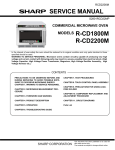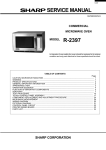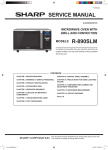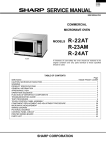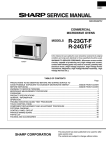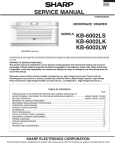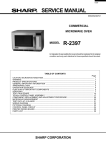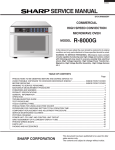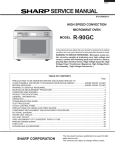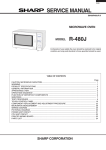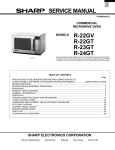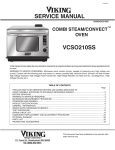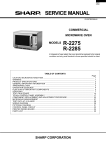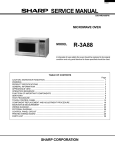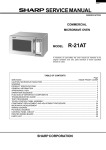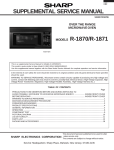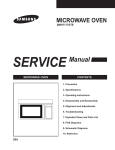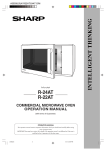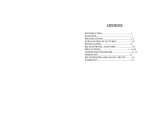Download Sharp Carousel R-9Z00 Service manual
Transcript
R-22AT R-24AT SERVICE MANUAL SY520R24ATK// COMMERCIAL MICROWAVE OVEN DOUBLE QUANTITY 1900W/R-24 EXPRESS DEFROST AT 1 12 2 13 3 14 4 15 5 16 6 17 7 18 8 19 9 20 0 MANUAL/ REHEAT STOP / CLEAR POWER LEVEL START SET R-24AT 11 CHECK MODELS VOLUME R-22AT R-24AT In interests of user-safety the oven should be restored to its original condition and only parts identical to those specified should be used. This revised service manual is applied to R-22AT from serial No. 050505509 and R-24AT from serial No. 050508658. Because many parts have been changed to improve quality of these models from May 2005 production. And the changed parts are not interchangeable. Please use this service manual for above products. For old products, please use old service manual (No.SX910R24ATK//) and technical reports. TABLE OF CONTENTS Page SERVICING ................................................................................................................. INSIDE FRONT COVER CAUTION, MICROWAVE RADIATION ............................................................................................................ 1 WARNING .......................................................................................................................................................... 1 PRODUCT SPECIFICATIONS ......................................................................................................................... 2 GENERAL INFORMATION ................................................................................................................................ 2 APPEARANCE VIEW ....................................................................................................................................... 3 OPERATION SEQUENCE ................................................................................................................................ 4 FUNCTION OF IMPORTANT COMPONENTS ................................................................................................ 6 TROUBLESHOOTING GUIDE .......................................................................................................................... 7 TEST PROCEDURE .......................................................................................................................................... 8 TOUCH CONTROL PANEL ASSEMBLY ........................................................................................................ 16 COMPONENT REPLACEMENT AND ADJUSTMENT PROCEDURE ........................................................... 24 MICROWAVE MEASUREMENT .................................................................................................................... 31 WIRING DIAGRAM ......................................................................................................................................... 32 PICTORIAL DIAGRAM ................................................................................................................................... 34 CONTROL PANEL CIRCUIT ........................................................................................................................... 35 PRINTED WIRING BOARD ............................................................................................................................. 36 PARTS LIST ................................................................................................................................................... 37 SHARP CORPORATION R-22AT R-24AT SERVICING WARNING TO SERVICE PERSONNEL Microwave ovens contain circuitry capable of producing very high voltage and current. Contact with following parts will result in electrocution. High voltage capacitors, High voltage transformers, Magnetrons, High voltage rectifier assembly, High voltage fuses, High voltage harness. REMEMBER TO CHECK 3D 1) Disconnect the supply. 2) Door opened, and wedged open. 3) Discharge high two voltage capacitors. WARNING: AGAINST THE CHARGE OF THE TWO HIGH-VOLTAGE CAPACITORS. The two high-voltage capacitors remain charged about 60 seconds after the oven has been switched off. Wait for 60 seconds and then short-circuit the connection of the two high-voltage capacitors (that is, of the connecting lead of the high-voltage rectifier) against the chassis with use of an insulated screwdriver. Sharp recommend that wherever possible fault-finding is carried out with the supply disconnected. It may, in some cases, be necessary to connect the supply after the outer case has been removed, in this event carry out 3D checks and then disconnect the leads to the primary of the power transformer. Ensure that these leads remain isolated from other components and the oven chassis. (Use insulation tape if necessary.) When the testing is completed carry out 3D checks and reconnect the leads to the primary of the power transformer. REMEMBER TO CHECK 4R 1) Reconnect all leads removed from components during testing. 2) Replace the outer case (cabinet). 3) Reconnect the supply. 4) Run the oven. Check all functions. Microwave ovens should not be run empty. To test for the presence of microwave energy within a cavity, place a cup of cold water on the oven turntable, close the door and set the microwave timer for one (1) minut. When the one minute has elapsed (timer at zero) carefully check that the water is now hot. If the water remains cold carry out 3D checks and re-examine the connections to the component being tested. When all service work is completed and the oven is fully assembled, the microwave power output should be checked and microwave leakage test should be carried out. R-22AT R-24AT SERVICE MANUAL PRODUCT SPECIFICATIONS COMMERCIAL MICROWAVE OVEN APPEARANCE VIEW R-22AT/ R-24AT GENERAL IMPORTANT INFORMATION This Manual has been prepared to provide Sharp Corp. Service engineers with Operation and Service Information. It is recommended that service engineers carefully study the entire text of this manual, so they will be qualified to render satisfactory customer service. CAUTION MICROWAVE RADIATION DO NOT BECOME EXPOSED TO RADIATION FROM THE MICROWAVE GENERATOR OR OTHER PARTS CONDUCTING MICROWAVE ENERGY. Service engineers should not be exposed to the microwave energy which may radiate from the magnetron or other microwave generating devices if it is improperly used or connected. All input and output microwave connections, waveguides, flanges and gaskets must be secured. Never operate the device without a microwave energy absorbing load attached. Never look into an open waveguide or antenna while the device is energized. OPERATING SEQUENCE FUNCTION OF IMPORTANT COMPONENTS SERVICING AND TROUBLESHOOTING CHART TEST PROCEDURE TOUCH CONTROL PANEL ASSEMBLY COMPONENT REPLACEMENT AND ADJUSTMENT PROCEDURE WARNING Never operate the oven until the following points are ensured. (A) The door is tightly closed. (B) The door brackets and hinges are not defective. (C) The door packing is not damaged. (D) The door is not deformed or warped. (E) There is not any other visible damage with the oven. Servicing and repair work must be carried out only by trained service engineers. MICROWAVE MEASUREMENT WIRING DIAGRAM All the parts marked "*" on parts list are used at voltages more than 250V. Removal of the outer wrap gives access to potentials above 250V. All the parts marked "∆" on parts list may cause undue microwave exposure, by themselves, or when they are damaged, loosened or removed. SHARP CORPORATION OSAKA, JAPAN 1 PARTS LIST R-22AT R-24AT PRODUCT DESCRIPTION SPECIFICATION ITEM DESCRIPTION Power Requirements Power Comsumption Power Output Case Dimensions Cooking Cavity Dimensions Control Complement for 230 - 240 Volts 50 Hertz Single phase, 3 wire earthed 2.4 kW Approx. 11 A [R-22AT] / 2.9 kW Approx. 13 A [R-24AT] 1500 W [R-22AT]/ 1900 W [R-24AT] nominal of RF microwave energy (measured by method of IEC 60705) Operating frequency 2450 MHz Width Height Depth 510mm 335 mm 470mm Width Height Depth 330 mm 180 mm 330mm Touch Control System The combination of cooking time and microwave power The oven can be programmed a series of up to 3 cookling stages. The combination of microwave power and cooking time that can be input as folllows. Cooking Sequence Micrwave power levelthat can be iused. Cooking time that can be iused. 1 Stage only 0-100% Max. 30 minutes 0-40% all stages Max. 30 minutes any stages Max. 60 minutes for 2 stages 2 or 3 Stage Max. 90 minutes for 3 stages 50-100% Max. 30 minutes for 3 stages NOTE:If the oven used with the power level above 40% on any stage, the maximum cooking time is 30 minutes in total. Microwave Power level 100% 90% 80% 70% 60% 50% 40% 30% 20% 10% 0% MANUAL / REPEAT key, NUMBER keys POWER LEVEL key, STOP / CLEAR key START Key, DOUBLE QUANTITY key EXPRESS DEFROST key, SET key CHECK key, VOLUME key CSet Weight Approx. 33 kg GENERAL INFORMATION WARNING THIS APPLIANCE MUST BE EARTHED IMPORTANT THE WIRES IN THIS MAINS LEAD ARE COLOURED IN ACCORDANCE WITH THE FOLLOWING CODE: GREEN-AND-YELLOW BLUE BROWN : EARTH : NEUTRAL : LIVE 2 R-22AT R-24AT APPEARANCE VIEW OVEN 1. 2. 3. 4. 5. 6. 7. 8. 9. 10. 11. 12. 13. 14. 15. 16. 17. 18 19 Control panel Hole for safety door latches Ceramic floor Splash cover Oven light Air intake filter Air intake openings Oven cavity 13 Door seals and sealing surfaces Door hinges Oven door with see-through window Door safety latches Door handle. Outer cabinet Removable cover over oven light bulb Air vent openings Power supply cord Mounting plate Screw for mounting plate 11 10 5 4 3 2 18 14 1 15 17 8 12 9 7 16 6 AUTO TOUCH CONTROL PANEL 3 4 2 1 11 DISPLAY AND INDICATORS Check indicators after the oven starts to confirm the oven is operating as desired. 6 DEF CHECK POWER NUMBER ON 1 2 3 5 7 8 9 % DOUBLE FILTER 10 1. Heating indicator This indicator shows cooking in progress. 2. Memory number indicator 3. Express defrost 4. Check mode indicator 5. Power level display 6. Time display 7. Filter indicator 8. Double quantity mode indicator 9. 3rd. stage indicator 10. 2nd. stage indicator 11. 1st. stage indicator DOUBLE QUANTITY 12 EXPRESS DEFROST OPERATING KEYS 12. 13. 14. 15. 16. 17. 18. 19. 20. 21. 19 DOUBLE QUANTITY key EXPRESS DEFROST key NUMBER keys MANUAL/ REPEAT key STOP/CLEAR key POWER LEVEL key START key SET key VOLUME key CHECK key 11 1 12 2 13 3 14 4 15 5 16 6 17 7 18 8 19 9 20 0 13 14 15 MANUAL/ REPEAT STOP / CLEAR 16 17 POWER LEVEL START 18 SET 19 CHECK VOLUME 20 21 INSTALLATION INFORMATION When this commercial microwave oven is installed near other commercial electrical appliances, connect a lead wire to each equivalent potential terminal with equipotential marking between them (insert a lead wire between a washer and an earth angle, and screw them), as shown in Fig. A-1, to make sure that they are at equivalent potential. If any lead wire is not connected between them, when person touch them he/she will get a electric shock. COMMERCIAL MICROWAVE OVEN Equipotential marking Lead wire OTHER COMMERCIAL ELECTRICAL APPLIANCE Screw Washer Equivalent potential terminal Earth angle (Equivalent potential terminal) Lead wire Figure A-1 3 R-22AT R-24AT OPERATION SEQUENCE Closing the door activates all door interlock switches (interlock switches and stop switch). to negative voltage of approximately 4000 volts D.C.. 3. The 2450 MHz microwave energy produced in the magnetron generates a wave length of 12.24 cm. This energy is channelled through the waveguide (transport channel) into the oven cavity, where the food is placed to be cooked. 4. When the cooking time is up, a signal tone is heard and the relays RY3+RY4 go back to their home position. The circuits to the high voltage transformers T1+T2. The relay RY1 remains and oven lamp, blower motor and antenna motors work for 1 minute. 5. When the door is opened during a cook cycle, the switches come to the following condition. IMPORTANT When the oven door is closed, the monitor switch contacts COM-NC must be open. When the microwave oven is plugged in a wall outlet (230 - 240 volts, 50Hz), the line voltage is supplied to the control unit through the noise filter. Figure O-1 on page 32 1. The digital display shows . IDLE CONDITION When the door is opened, the contacts of the interlock switches SW1+SW2 and stop switch SW5 open, initiating the following: Figure O-2 on page 32 1. A signal is input to the control unit energizing the coil of shut-off relay RY-1. 2. The shut-off relay RY-1 contacts close completing circuits to turn on the oven lamp, blower motor and antenna motors. 3. If the door remains open, 60 seconds later the control unit de-energizes shut-off relay RY-1 turning off the oven lamp, blower motor and antenna motors. When the door is closed, the contacts of the interlock switches SW1+SW2 and stop switch SW5 close. With the closing of the stop switch SW5 contacts, an additional circuit is provided which will permit the operation of the oven when one of the touch pads is depressed. Since the control is enabled through the stop switch SW5, the door must be closed before the touch pads will be effective. When the door is closed, a full 60 second IDLE condition is always provided for selecting and pressing the desired touch pads. A 60 second IDLE condition will also follow the end of each cook cycle. SWITCH Interlock switches Monitor switches Stop switch The circuits to the high voltage transformers T1+T2 are cut off when the interlock and stop switches SW1+SW2+SW5 are made open. The blower motor BM, antenna motors and oven lamp remains on even if the oven door is opened after the cooking cycle has been interrupted, because the relay RY1 stays closed. Shown in the display is the remaining time, but the program is cancelled if the oven is not started within 1 minute. 6. MONITOR SWITCH CIRCUIT The monitor switches SW3+SW4 are mechanically controlled by oven door, and monitors the operation of the interlock switches SW1+SW2. 6-1. When the oven door is opened during or after the cycle of a cooking program, the interlock switches SW1+SW2 and stop switches SW5 must open their contacts first. After that the contacts (COM-NC) of the monitor switches SW3+SW4 can be closed. 6-2. When the oven door is closed, the contacts (COMNC) of the monitor switches SW3+SW4 must be opened first. After that the contacts (COM-NO) of the interlock switches SW1+SW2 and stop switch SW5 must be closed. 6-3. When the oven door is opened and the contacts of the interlock switch SW1 (or SW2) remain closed, remains closed, the fuse F1 F10A (or F2 F10A) will blow, because the monitor switch SW3 (or SW4) is closed and a short circuit is caused. MICROWAVE COOKING CONDITION Touch MANUAL/REPEAT key and enter a desired cooking time with the touching NUMBER key. And then touch START key. NOTE: The programme and the check are canceled when any keys are not touched for more than 3 minutes during programming. Function sequence Figure O-3 on page 33 CONNECTED COMPONENTS Oven lamp/ Blower motor/ Antenna motors High voltage transformer T1 High voltage transformer T2 CONTACT COM-NO COM-NC COM-NO CONDITION DURING DOOR OPEN COOKING (NO COOKING) Closed Open Open Closed Closed Open RELAY RY1 RY3 RY4 MICROWAVE VARIABLE COOKING When the microwave oven is preset for variable cooking power, the line voltage is supplied to the high voltage transformers T1+T2 intermittently within a 48 second time base through the contacts of the relays RY3+RY4. The following levels of microwaves power are given. 1. The line voltage is supplied to the primary winding of the two high voltage transformers. The voltage is converted to about 3.3 volts A.C. output on the filament winding and high voltage of approximately 2000 volts A.C. on the secondary winding. 2. The filament winding voltage (3.3 volts) heats the magnetron filament and the high voltage (2000 volts) is sent to the voltage doubling circuit, where it is doubled 4 R-22AT R-24AT 48 sec. ON Number key 44sec. ON Number key 9 40 sec. ON Number key 8 36 sec. ON Number key 7 32 sec. ON Number key 6 26 sec. ON Number key 5 22 sec. ON Number key 4 16 sec. ON Number key 3 12 sec. ON Number key 2 8 sec. ON Number key 1 0 sec. ON Number key 0 NOTE: The ON/OFF time ratio does not exactly correspond to the percentage of microwave power, because approx. 3 seconds are needed for heating up the magnetron filament. TWO MAGNETRON OPERATION SYSTEM Two magnetrons MG1+MG2 are equipped in order to get higher microwave power output. The primary windings of the high voltage transformers T1+T2 are connected so that each magnetron can be oscillated alternatively according to the frequency of the power supply. Refer to the Figure B-1 and B-2. T2: HIGH VOLTAGE TRANSFORMER (REAR) H. V. RECTIFIER MG2: MAGNETRON (LOWER) H. V. FUSE C1: H.V. CAPACITOR C2: H.V. CAPACITOR H. V. FUSE T1: HIGH VOLTAGE TRANSFORMER (FRONT) H. V. RECTIFIER MG1: MAGNETRON (UPPER) Figure B-1. High Voltage Circuit OPERATION OF MAGNETRON COMMERCIAL FREQUENCY (50HZ) POWER OUTPUT BY MAGNETRON T1 POWER OUTPUT BY MAGNETRON T2 Figure B-2. Operation of Magnetron 5 R-22AT R-24AT FUNCTION OF IMPORTANT COMPONENTS 3. If the door is opened and the interlock switch SW1 (or SW2) contacts fail to open, the fuse F1 F10A (or F2 F10A) blows simultaneously with closing of the monitor switch SW3 (or SW4) contacts. CAUTION:BEFORE REPLACING A BLOWN FUSE F1 F10A (OR F2 F10A) TEST THE INTERLOCK SWITCH SW1 (OR SW2) AND MONITOR SWITCHE SW3 (OR SW4) FOR PROPER OPERATION. (REFER TO CHAPTER “TEST PROCEDURE”). DOOR OPEN MECHANISM 1. The door release lever is pulled. 2. The upper latch head is lifted up by the linked door release lever. 3. The head lever is lifted up by the door release lever. 4. The joint lever is lifted up by the head lever. 5. The lower latch head is lifted up by the joint lever. 6. Now both latch heads are lifted up, so they can be released from the latch hook. 7. Now the door can be opened. Door release lever NOISE FILTER Latch head The noise filter assembly prevents radio frequency interference that might flow back in the power circuit. Latch hook FUSES F1, F2 F10A 250V 1. If the wire harness or electrical components are shortcircuited, this fuse blows to prevent an electric shock or fire hazard. 2. The fuse F1 F10A (or F2 F10A) also blows when interlock switch SW1 (or SW2) remains closed with the oven door open and when the monitor switches SW3 (or SW4) closes. SW4: Monitor switch (Oven side) SW3: Monitor switch SW2: Interlock switch (Oven side) SW1: Interlock switch Joint lever Head lever WEAK POINT F3 If the wire harness or electrical components make a shortcircuit, this weak point F3 blows to prevent an electric shock or fire hazard. SW5: Stop switch Latch head HIGH VOLTAGE FUSE(S) F4, F5 Figure D-1. Door Open Mechanism The high voltage fuse blows when the high voltage rectifier or the magnetron is shorted. INTERLOCK SWITCHES SW1, SW2 AND STOP SWITCH SW5 MAGNETRON TEMPERATURE FUSES TF1, TF2 1. When the oven door is closed, the contacts COM-NO must be closed. 2. When the oven door is opened, the contacts COM-NO must be opened. The temperature fuses TF1, TF2 located on the top of the upper and lower waveguide, are designed to prevent damage to the magnetrons MG1, MG2. If an over heated condition develops in the tube due to blower motor failure, obstructed air ducts, dirty or blocked air intake, etc., the circuit to the magnetrons are interrupted. Under normal operation, the temperature fuses remains closed. However, when abnormally high temperatures are generated within the magnetrons, the temperature fuses will open at 150˚C causing the microwave energy to stop. The defective temperature fuses must be replaced with new rated ones. MONITOR SWITCHES SW3, SW4 The monitor switches SW3, SW4 are activated (the contacts opened) the upper latch head and switch lever A while the door is closed. The switch SW3 (or SW4) is intended to render the oven inoperative by means of blowing the fuse F1 F10A (or F2 F10A) when the contacts of the interlock switch SW1 (or SW2) fail to open when the door is opened. EXHAUST TEMPERATURE FUSE TF3 Function 1. When the door is opened, the monitor switches SW3 +SW4 contacts close (to the ON condition) due to their being normally closed. At this time the interlock switch SW1+SW2 are in the OFF condition (contacts open) due to their being normally open contact switches. 2. As the door goes to a closed position, the monitor switches SW3+SW4 contacts are opened and interlock switch SW1+SW2 contacts are closed (On opening the door, each of these switches operate inversely.) The temperature fuse TF3, located on the side of the exhaust duct assembly, is designed to prevent damage to the oven by fire. If the food load is overcooked, by either error in cook time or defect in the control unit, the temperature fuse will open. Under normal operation, the oven temperature fuse remains closed. However, when abnormally high temperatures are generated within the oven cavity, the oven temperature fuse will open at 120˚C, causing the oven to shut down. The defective temperature fuse must be replaced with new rated one. 6 R-22AT R-24AT EXHAUST OVEN THERMISTOR TH3 BLOWER MOTOR BM The thermistor is a negative temperature coefficient type. The temperature in the exhaust duct is detected through the resistance of the thermistor. If the temperature is high, the control panel will display “EE7” and the oven will stop to avoid overheating and catching fire. If the thermistor is open, the control panel will display "EE6" and the oven will stop. The blower motor BM drives a blade which draws external cool air into the oven. This cool air is directed through the air vanes surrounding the magnetrons and cools the magnetrons. This air is channelled through the oven cavity to remove steam and vapours given off from the heating foods. It is then exhausted through the exhausting air vents at the oven cavity. ANTENNA MOTORS SM MAGNETRON THERMISTORS TH1, TH2 The upper and lower antenna motors SM drive stirrer antennas. The thermistor is a negative temperature coefficient type. The air temperature around the magnetron is detected through the resistance of the thermistor. If the temperature is high, the control panel will display "EE17" and the oven will stop to protect the lower magnetron against overheat. If the magnetron thermistor is open, the control panel will display "EE16" and the oven will stop. If the magnetron thermistor is short, the control panel will display "EE19" and the oven will stop. OVEN LAMP OL The oven cavity light illuminates the interior of the oven so that food being cooked can be examined visually through the door window without having to open the door. The oven lamp is on during the cooking cycle and idle condition. TROUBLESHOOTING GUIDE When troubleshooting the microwave oven, it is helpful to follow the Sequence of Operation in performing the checks. Many of the possible causes of trouble will require that a specific test be performed. These tests are given a procedure letter which will be found in the “Test Procedure”section. IMPORTANT: If the oven becomes inoperative because of a blown fuse F1 F10A (or F2 F10A) in the interlock switch SW1 (or SW2) - monitor switches SW3 (or SW4) , check the interlock switch SW1 (or SW2) and monitor switches SW3 (or SW4) before replacing the fuse F1 F10A (or F2 F10A). 7 ON CONDITION C C B B A A OFF CONDITION J J I I I L L H H H F G G E E E E D D D “ . “ does not appear on display when power cord is plugged into wall outlet. Control panel can not accept key in. Fuse F1 or F2 blows when the door is opened. Home fuse blows when power cord is plugged into wall outlet. Weak point F3 blows when power cord is plugged into wall outlet. Oven lamp, fan motor and antenna motors do not work for 1 minute when the door is opened or after cooking. Fuse F1 or F2 blows when power cord is plugged into wall outlet. Oven lamp does not light when door is opened. (Blower and antenna motors work) Blower motor does not work when door is opened. (Oven lamp lights and antenna motors work) “EE 1” (Magnetron MG1 failure) “EE 2” (Magnetron MG2 failure) “EE 3” (Magnetron MG1 and MG2 failure) “EE 6” (Exhaust thermistoropen) “EE 7” (Exhaust air temperature is high) “EE 9” (Exceeded max. heating time) Oven lamp, blower motor and antenna motors do not work. Oven lamp does not work. Blower motor does not work. Oven does not stop after end of cooking cycle. Home fuse blows when starting the oven. Oven goes into cook cycle but shuts down before end of cooking cycle. It passed more than 1 minute after cooking but oven lamp, blower motor and stirrer motors do not stop. “EE 16” (Thermistor of magnetron are open.) “EE 17” (Magnetron temperature is high.) “EE 19” (Magnetron thermistor short) “EE 10” (Fault of memory) Antenna motors do not work. K PROBLEM P O O O M CONDITION N POSSIBLE CAUSE AND DEFECTIVE PARTS TESTPROCEDURE R-22AT R-24AT EEP ROM I-2 KEY UNIT TOUCH CONTROL TRANSFORMER T3 Due to programme lock Over the max. cooking time No power at wall outlet HOME FUSE or BREAKER Mis adjustment of switches FUSE 2.5A RELAY RY-4 RELAY RY-3 RELAY RY-1 TOUCH CONTROL PANEL Opened wire harness Shorted wire harness POWER SUPPLY CORD NOISE FILTER OVEN LAMP OR SOCKET BLOWER MOTOR BM ANTENNA MOTORS SM EXHAUST THERMISTOR TH3 MAGNETRON THERMISTOR (Lower) TH2 MAGNETRON THERMISTOR (Upper) TH1 HIGH VOLTAGE FUSE F5 HIGH VOLTAGE FUSE F4 EXHAUST TEMPERATURE FUSE TF3 MAGNETRON TEMPERATURE FUSE TF2 MAGNETRON TEMPERATURE FUSE TF1 WEAK POINT F3 FUSE F10A F2 FUSE F10A F1 STOP SWITCH SW5 MONITOR SWITCH SW4 MONITOR SWITCH SW3 NTERLOCK SWITCH SW2 INTERLOCK SWITCH SW1 H.V. CAPACITOR C2 H.V. CAPACITOR C1 H.V. WIRE HARNESS H.V. RECTIFIER ASSEMBLY FOR MG2 H.V. RECTIFIER ASSEMBLY FOR MG1 HIGH VOLTAGE TRANSFORMER T2 (Rear) HIGH VOLTAGE TRANSFORMER T1 (Front) MAGNETRON MG2 (Lower) MAGNETRON MG1 (Upper) 8 R-22AT R-24AT TEST PROCEDURES PROCEDURE LETTER A MAGNETRON TEST COMPONENT TEST NEVER TOUCH ANY PART IN THE CIRCUIT WITH YOUR HAND OR AN INSULATED TOOL WHILE THE OVEN IS IN OPERATION. CARRY OUT 3D CHECKS. Isolate the magnetron from high voltage circuit by removing all leads connected to filament terminal. To test for an open circuit filament use an ohmmeter to make a continuity test between the magnetron filament terminals, the meter should show a reading of less than 1 ohm. To test for short circuit filament to anode condition, connect ohmmeter between one of the filament terminals and the case of the magnetron (ground). This test should be indicated an infinite resistance. If a low or zero resistance reading is obtained then the magnetron should be replaced. MICROWAVE OUTPUT POWER (1 litre water load) The following test procedure should be carried out with the microwave oven in a fully assembled condition (outer case fitted). Microwave output power from the magnetron can be measured by way of IEC 60705, i.e. it is measured by how much power the water load can absorb. To measure the microwave output power in the microwave oven, the relation of calorie and watt is used. When P(W) heating works for t(second), approximately P x t/4.187 calorie is generated. On the other hand, if the temperature of the water with V(ml) rises ∆T (°C) during this microwave heating period, the calorie of the water is V x ∆T. The formula is as follows; P x t / 4.187 = V x ∆ T+ 0.55 x mc (T2-T0) P (W) = 4.187 x V x ∆T / t + 0.55 x mc (T2-T0)/t Our condition for water load is as follows: Room temperature (T0) ...... around 20°C Power supply Voltage .............. Rated voltage Water load ..................................... 1000 g Initial temperature (T1) ...................... 10±1°C Mass of container (mc) ..... 330 g Heating time ................ 28 sec. [R-22AT] / 22sec. [R-24AT] T2 ......... Final Temperature P = 150 x ∆T [R-22AT] / P = 190 x ∆T [R-24AT] Measuring condition: 1. Container The water container must be a cylindrical borosilicate glass vessel having a maximum material thickness of 3 mm and an outside diameter of approximately 190 mm. 2. Temperature of the oven and vessel The oven and the empty vessel are at ambient temperature prior to the start the test. 3. Temperature of the water The initial temperature of the water is (10±1)°C. 4. Select the initial and final water temperature so that the maximum difference between the final water temperature and the ambient temperature is 5°C. 5. Select stirring devices and measuring instruments in order to minimize addition or removal of heat. 6. The graduation of the thermometer must be scaled by 0.1°C at minimum and be an accurate thermometer. 7. The water load must be (1000±5) g. 8. “t” is measured while the microwave generator is operating at full power. Magnetron filament heatup time is not included. NOTE: The operation time of the microwave oven is “t + 3” sec. (3 sec. is magnetron filament heat-up time.) Measuring method: 1. Measure the initial temperature of the water before the water is added to the vessel. (Example: The initial temperature T1 = 11°C) 2. Add the 1 litre water to the vessel. 3. Place the load on the centre of the shelf. 4. Operate the microwave oven at HIGH until the temperature of the water rises by a value ∆ T of (10 ± 2) K. 5. Stir the water to equalize temperature throughout the vessel. 6. Measure the final water temperature. (Example: The final temperature T2 = 21°C) 7. Calculate the microwave power output P in watts from above formula. 9 R-22AT R-24AT TEST PROCEDURES PROCEDURE LETTER COMPONENT TEST Room temperature ................................................................................................. T0 = 21°C Initial temperature .................................................................................................. T1 = 11°C Temperature after (28 + 3) = 31 sec [for R-22AT].................................................. T2 = 21°C Temperature after (22 + 3) = 25 sec [for R-24AT].................................................. T2 = 21°C Temperature difference Cold-Warm ...................................................................... ∆T1 = 10˚C Measured output power The equation is “P = 150 x ∆T” [for R-22AT] ........................... P = 150 x 10°C = 1500 Watts The equation is “P = 190 x ∆T” [for R-24AT] ........................... P = 190 x 10°C = 1900 Watts JUDGMENT: The measured output power should be within the range of ± 15 % of the rated output power. CAUTION: 1°C CORRESPONDS TO 150 WATTS [R-22AT]/ 190 WATTS [R-24AT]. REPEAT MEASUREMENT IF THE POWER IS INSUFFICIENT. 1000g 1000g 1000g T1˚C Heat up for 31 sec. for R-22AT Heat up for 25 sec. for R-24AT T2˚C MICROWAVE OUTPUT POWER (2000 cc alternative method) The power output of this oven is rated using the method specified by IEC 60705. Full details of how to curry out this procedure can be found in the Sharp Technical Training notes which is available from Sharp Parts Centre (part number SERV-LITMW01). The IEC-60705 procedure must be carried out using laboratory-type procedures and equipment. These requirements make the procedure unsuitable for routine performance checks. NOTE: The following test method gives an indication of the output power only, it cannot be used to establish the actual/rated output power. If the true output power is required, then the IEC60705 test method must be used. Alternative simplified method: 1. Place 2 litres of cold water (between 12°C and 20°C) in a suitable container. 2. Stir the water and measure the temperature in °C. Note temperature as T1. 3. Place the container in the microwave and heat the water for 56 sec. [R-22AT]/ 44 sec. [R-24AT] on fill power. 4. When the 56 sec. [R-22AT]/ 44 sec. [R-24AT] is completed, remove the container and stir the water. Note temperature as T2. 5. Calculate the output power using the following formula: R.F. Power Output = (T2 - T1) x 150 for R-22AT. R.F. Power Output = (T2 - T1) x 190 for R-24AT. NOTE: The result from this test should be within the allowance of 2000cc alternative method. (±10%). MICROWAVE LEAKAGE TEST This oven should be tested for microwave leakage on completion of any repair or adjustment, following the procedure described in the Sharp Technical Training notes (part number SERV-LITMW01). The maximum leakage permitted in BS EN 60335-2-25 is 50W/m2 (equivalent to 5W/m2), however it is not normal to detect any significant leakage, therefore, any leakage which is detected should be investigated. It is essential that only leakage detectors with current calibration traceable to National Physical Laboratories are used. Suitable leakage detectors: CELTEC A100 APOLLO X1 10 R-22AT R-24AT TEST PROCEDURES PROCEDURE LETTER COMPONENT TEST B HIGH VOLTAGE TRANSFORMER TEST WARNING: High voltage and large currents are present at the secondary winding and filament winding of the high voltage transformer. It is very dangerous to work near this part when the oven is on. NEVER make any voltage measurements of the high-voltage circuits, including the magnetron filament. CARRY OUT 3D CHECKS. Disconnect the leads to the primary winding of the high voltage transformer. Disconnect the filament and secondary winding connections from the rest of the HV circuitry. Using an ohmmeter, set on a low range, it is possible to check the continuity of all three windings. The following readings should be obtained: R-22AT R-24AT a. Primary winding approximately 1.8 Ω approximately 1.2 Ω b. Secondary winding approximately 75 Ω approximately 75 Ω c. Filament winding less than 1 Ω If the readings obtained are not stated as above, then the high voltage transformer is probably faulty and should be replaced. CARRY OUT 4R CHECKS. C HIGH VOLTAGE RECTIFIER ASSEMBLY TEST CARRY OUT 3D CHECKS. Isolate the high voltage rectifier assembly from the HV circuit. The high voltage rectifier can be tested using an ohmmeter set to its highest range. Connect the ohmmeter across the terminal B+C of the high voltage rectifier and note the reading obtained. Reverse the meter leads and note this second reading. The normal resistance is infinite in one direction and more than 100 kΩ in the other direction. CARRY OUT 4R CHECKS. C B HIGH VOLTAGE RECTIFIER NOTE: FOR MEASUREMENT OF THE RESISTANCE OF THE RECTIFIER, THE BATTERIES OF THE MEASURING INSTRUMENT MUST HAVE A VOLTAGE AT LEAST 6 VOLTS, BECAUSE OTHERWISE AN INFINITE RESISTANCE MIGHT BE SHOWN IN BOTH DIRECTIONS. D HIGH VOLTAGE CAPACITOR TEST CARRY OUT 3D CHECKS. A. Isolate the high voltage capacitor from the circuit. B. Continuity check must be carried out with measuring instrument which is set to the highest resistance range. C. A normal capacitor shows continuity for a short time (kick) and then a resistance of about 10MΩ after it has been charged. D. A short-circuited capacitor shows continuity all the time. E. An open capacitor constantly shows a resistance about 10 MΩ because of its internal 10MΩ resistance. F. When the internal wire is opened in the high voltage capacitor shows an infinite resistance. G. The resistance across all the terminals and the chassis must be infinite when the capacitor is normal. If incorrect reading are obtained, the high voltage capacitor must be replaced. CARRY OUT 4R CHECKS. E SWITCH TEST CARRY OUT 3D CHECKS. Isolate the switch to be tested and using an ohmmeter check between the terminals as described in the following table. 11 R-22AT R-24AT TEST PROCEDURES PROCEDURE LETTER COMPONENT TEST Table: Terminal Connection of Switch Plunger Operation COM to NO COM to NC Released Depressed Open circuit Short circuit Short circuit Open circuit COM; Common terminal, NO; Normally open terminal NC; Normally close terminal If incorrect readings are obtained, make the necessary switch adjustment or replace the switch. CARRY OUT 4R CHECKS. F WEAK POINT F3 TEST CARRY OUT 3D CHECKS. If the weak point F3 is blown, there could be a shorts or grounds in electrical parts or wire harness. Check them and replace the defective parts or repair the wire harness. CARRY OUT 4R CHECKS. CAUTION: Only replace weak point F3 with the correct value replacement. G FUSE F1, F2 F10A TEST CARRY OUT 3D CHECKS. If the fuse F1 F10A (or F2 F10A) is blown when the door is opened, check the interlock switch SW1 (or SW2) and monitor switch SW3 (or SW4). If thefuse F1 F10A (or F2 F10A) is blown by incorrect door switching replace the defective switch(s) and the fuse F1 F10A (or F2 F10A). CARRY OUT 4R CHECKS. CAUTION: Only replace fuse F1 F10A (or F2 F10A) with the correct value replacement. H TEMPERATURE FUSE TF1, TF2, TF3 TEST 1. CARRY OUT 3D CHECKS. 2. A continuity check across the temperature fuse terminals should indicate a closed circuit unless the temperature of the temperature fuse reaches specfied temperature as shown below. Open temperature Magnetron temperature fuse (Upper) TF1 Magnetron temperature fuse (Lower) TF2 Exhaust temperature fuse TF3 Close temperature Display or Condition EE1 150˚C Non resetable EE3 type EE2 120˚C Check point Magnetron MG1 Failure: Test magnetron MG1 and Blower motor. Magnetron MG1, MG2 Failure: Test magnetron MG1, MG2. Check blower motor and ventilation opening. Magnetron MG2 Failure: Test magnetron MG2 and Blower motor. Non resetable Oven shut Food has been burned in oven. type Temperature of oven inside is very high. off 3. CARRY OUT 4R CHECKS. CAUTION: IF THE temperature fuse INDICATES AN OPEN CIRCUIT AT ROOM TEMPERATURE, REPLACE temperature fuse. I THERMISTOR TH1, TH2, TH3 TEST 1. CARRY OUT 3D CHECKS. 2. Follow the procedures below for each thermistor. 2-1. THERMISTOR TEST Disconnect the connector of the thermistor from the switch harness. Measure the resistance of the magnetron thermistor with an ohmmeter. Connect the ohmmeter leads to the leads of the thermistor. Resistance: Approx. 500 kΩ -- 1 MΩ 12 R-22AT R-24AT TEST PROCEDURES PROCEDURE LETTER COMPONENT TEST If the meter does not indicate above resistance, replace the thermistor. 3. CARRY OUT 4R CHECKS. J MOTOR WINDING TEST CARRY OUT 3D CHECKS. Disconnect the leads from the motor. Using an ohmmeter, check the resistance between the two terminals. Resistance of Blower motor should be approximately 60Ω. Resistance of Antenna motor should be approximately 8.8 kΩ. If incorrect readings are obtained, replace the motor. CARRY OUT 4R CHECKS. K NOISE FILTER TEST CARRY OUT 3D CHECKS. Disconnect the leads from the terminals of noise filter. Using an ohmmeter, check between the terminals as described in the following table. NOISE FILTER INDICATION OF OHMMETER Between N and L Approx. 680 kΩ L N MEASURING POINT F3 : WEAK POINT NOISE SUPPRESSION COIL Between terminal N and WHIT Short circuit Between terminal L and BLK Short circuit DISCHARGE RESISTOR 680 kΩ 1/2W LINE CROSS CAPACITOR 0.22µF/ AC250V DISCHARGE RESISTOR 10 MΩ 1/2W LINE CROSS CAPACITOR 10000 pF/ AC250V If incorrect readings are absorbed, replace the noise filter. WHT LINE CROSS CAPACITOR 10000 pF/ AC250V BLK CARRY OUT 4R CHECKS. L HIGH VOLTAGE FUSE F4, F5 TEST CARRY OUT 3D CHECKS. If the high voltage fuse F4 (or F5) is blown, there could be a short in the high voltage rectifier or the magnetron MG1 (or MG2). Check them and replace the defective parts and the high voltage fuse F4 (or F5). CARRY OUT 4R CHECKS. CAUTION: M Only replace high voltage fuse with the correct value replacement. TOUCH CONTROL PANEL ASSEMBLY TEST The touch control panel consists of circuits including semiconductors such as LSI, IC, etc. Therefore, unlike conventional microwave ovens, proper maintenance cannot be performed with only a voltmeter and ohmmeter. In this service manual, the touch control panel assembly is divided into two units, Control Unit and Key Unit, troubleshooting by unit replacement is described according to the symptoms indicated. 1. Key Unit Note : Check key unit ribbon connection before replacement. The following symptoms indicate a defective key unit. Replace the key unit. a) When touching the pads, a certain pad produces no signal at all. b) When touching the pads, sometimes a pad produces no signal. 2. Control Unit The following symptoms may indicate a defective control unit. Replacing the control unit. Before replacing the control unit, perform the key unit test (Procedure N) to determine if control unit is faulty. 2-1 Programming problems. a) When touching the pads, a certain group of pads do not produce a signal. 2-2 Display problems. a) For a certain digit, all or some segments do not light up. b) For a certain digit, brightness is low. c) Only one indicator does not light. d) The corresponding segments of all digits do not light up; or they continue to light up. e) Wrong figure appears. 13 R-22AT R-24AT TEST PROCEDURES PROCEDURE LETTER COMPONENT TEST f) A certain group of indicators do not light up. g) The figure of all digits flicker. 2-3 Other possible problems caused by defective control unit. a) Buzzer does not sound or continues to sound. b) Cooking is not possible. N KEY UNIT TEST CARRY OUT 3D CHECKS. If the display fails to clear when the STOP/CLEAR pad is depressed, first verify the flat ribbon cable is making good contact, verify that the stop switch operates properly; that is the contacts are closed when the door is closed and open when the door is open. If the stop switch is good, disconnect the flat ribbon cable that connects the key unit to the control unit and make sure the stop switch is closed (either close the door or short the stop switch connector ). Use the key unit matrix indicated on the control panel schematic and place a jumper wire between the pins that correspond to the STOP/CLEAR pad making momentary contact. If the control unit responds by clearing with a beep, the key unit is faulty and must be replaced. If the control unit does not respond, it is faulty and must be replaced. If a specific pad does not respond, the above method may be used (after clearing the control unit ) to determine if the control unit or key pad is at fault. CARRY OUT 4R CHECKS. G1 G2 G3 G4 17 G9 18 G10 19 G11 20 G12 O G5 G6 G7 G8 7 8 9 0 15 16 5 6 13 14 3 4 11 12 1 2 RELAY TEST CARRY OUT 3D CHECKS. Remove the outer case and check voltage between Pin Nos. 3 and 5 of the connector (A) on the control unit with an A.C. voltmeter. The meter should indicate 230 - 240 volts, if not check control unit circuity. RY1, RY3 and RY4 Relay Test These relays are operated by D.C. voltage. Check voltage at the relay coil with a D.C. voltmeter during the microwave cooking operation. DC. voltage indicated ............................. Defective relay. DC. voltage not indicated ....................... Check diode which is connected to the relay coil. If diode is good, control unit is defective. RELAY SYMBOL RY1 RY3 RY4 OPERATIONAL VOLTAGE APPROX. 25.9V D.C. APPROX. 25.0V D.C. APPROX. 25.0V D.C. CONNECTED COMPONENTS Oven lamp, Blower motor and Antenna motors High voltage transformer (MG1) High voltage transformer (MG2) CARRY OUT 4R CHECKS. P PROCEDURES TO BE TAKEN WHEN THE FUSE ON THE PRINTED WIRING BOARD(PWB) IS OPEN To protect the electronic circuits, this model is provided with a fine fuse added to the primary on the PWB. If the fuse is open, follow the troubleshooting guide given below for repair. Problem: POWER ON, indicator does not light up. CARRY OUT 3D CHECKS. 14 R-22AT R-24AT TEST PROCEDURES PROCEDURE LETTER COMPONENT TEST STEPS OCCURRENCE CAUSE OR CORRECTION 1 The rated AC voltage is not present at POWER terminal of CPU connector (CN-A). Check supply voltage and oven power cord. 2 The rated AC voltage is present at primary side of touch control transformer. Touch control transformer or secondary circuit defective. Check and repair. 3 Fuse on the PWB is open. Replace the fuse with new one. (CARRY OUT 3D CHECKS BEFORE REPAIR) NOTE: *At the time of these repairs, make a visual inspection of the varistor for burning damage and examine the transformer with tester for the presence of layer short-circuit (check primary coil resistance). If any abnormal condition is detected, replace the defective parts. CARRY OUT 4R CHECKS. 15 R-22AT R-24AT TOUCH CONTROL PANEL ASSEMBLY OUTLINE OF TOUCH CONTROL PANEL 2. Key Unit The key unit is composed of a matrix circuit in which when a key it touched, one of signals P33 - P34 generated by the LSI, is passed through the key and returned to the LSI as one of signals P24 - P27. This model has 20 Memory pads. When the oven is shipped, Memory pad 1 to 10 are set as follows: fig.1. The touch control section consists of the following units as shown in the touch control panel circuit. (1) Control Unit (2) Key Unit The principal functions of these units and the signals communicated among them are explained below. 1. Control Unit Signal of key touch and oven function control are all processed by one microcomputer. 1) Power Supply Circuit This circuit changes output voltage at the secondary side of the touch control transformer to voltages required at each part by full wave rectifying circuit, constant voltage circuit, etc.. 2) Reset Circuit This is an Auto-clear Circuit, i.e., a reset circuit, which enables IC1 to be activated from initial state. 3) Power Synchronizing Signal Generating Circuit This is a circuit for generating power synchronizing signal by virtue of the secondary side output of touch control transformer. This signal is used for a basic frequency to time processing and so on. 4) Clock Circuit This is a circuit for controlling clock frequency required for operating I-1. 5) I-1 (Main Processor) This is a one-chip microcomputer, responsible for controlling the entire control unit. 6) I-2 (Memory Processor) This is a memory IC, responsible for memory function. 7) Display Circuit This is a circuit for driving display tubes by I-1 output. 8) Key Input Circuit This is a circuit for transmitting key input information to I-1. 9) Sound-body Driving Circuit This is a circuit for driving sound body by I-1 output. 10) Relay Driving Circuit This is a circuit for driving output relay by I-1 output. 11) Stop Switch Circuit This is a circuit for driving I-1 to detect door opening/ closing. 12) Exhaust Air Temperature Detecting Circuit This is a circuit for transmitting output change of thermistor (Exhaust thermistor) to I-1. 13) Magnetron Temperature Circuit. (Detect Noload or Fan Lock) This is a circuit for transmitting output change of thermistor (Magnetron thermistor) to I-1. Memory No. Cook Time 1 5 sec. 2 10 sec. 3 20 sec. 4 30 sec. 5 40 sec. 6 50 sec. 7 1 min. 8 1 min. 15 sec. 9 1 min.30 sec. 0 2 mins. Output Power 100% 100% 100% 100% 100% 100% 100% 100% 100% 100% (fig. 1) This model has a double quantity pad. When the oven is shipped, Magnification "1.8" is preset in the double quantity pad. This model has an defrost pad. When the oven is shipped, defrost is set as follows: fig.2. POWER DEFROSTING TIME 1STAGE 2STAGE 3STAGE 40% 30% 20% 0.2T+20sec 0.13T+30sec. 0.67T-50sec. (fig. 2) NOTE : "CHECK" indicator will flash at half of defrosting time. 16 R-22AT R-24AT DESCRIPTION OF LSI LSI(IXA222DR) The I/O signal of the LSI(IXA222DR) is detailed in the following table. Pin No. 1 Signal VCC I/O IN 2 VEE IN Anode (segment) of Fluorescent Display light-up voltage: -35V. Vp voltage of power source circuit input. 3 AVSS IN Reference voltage input terminal. A reference voltage applied to the A/D converter in the LSI. Connected to DC. (-5V) 4 VREF IN Reference voltage input terminal. A reference voltage applied to the A/D converter in the LSI. Connected to GND. AN7-AN6 IN Terminal to switch the specification. 7 AN5 IN Temperature measurement input: EXHAUST THERMISTOR By inputting DC voltage corresponding to the temperature detected by the thermistor, this input is converted into temperature by the A/D converter built into the LSI. 8 AN4 IN Input signal which communicates the door open/close information to LSI. Door closed; "H" level signal (0V). Door opened; "L" level signal (-5.0V). 9 AN3 - 10 AN2 IN Temperature measurement input: MAGNETRON THERMISTOR TH2. By inputting DC voltage corresponding to the temperature detected by the thermistor, this input is converted into temperature by the A/D converter built into the LSI. 11 AN1 IN Temperature measurement input: MAGNETRON THERMISTOR TH1. By inputting DC voltage corresponding to the temperature detected by the thermistor, this input is converted into temperature by the A/D converter built into the LSI. 12 AN0 - Terminal not used. P55-P54 - Terminal not used. P53 OUT 5-6 13-14 15 Description Power source voltage: GND. VC voltage of power source circuit input. Connected to GND. Terminal not used. Magnetron (MG1) high-voltage circuit driving signal. To turn on and off the cook relay. In 100% power level operation, "L" level during cooking; "H" level otherwise. In other power level operation (90, 80, 70, 60, 50, 40, 30, 20, 10 or 0%), "H" and "L" level is repeated according to power level. Power level 16 P52 - 17 P51 OUT P50 - OFF Power level ON OFF 48sec. 0sec. 40% 22sec. 26sec. 90% 44sec. 4sec. 30% 16sec. 32sec. 80% 70% 40sec. 8sec. 36sec. 12sec. 20% 10% 12sec. 36sec. 8sec. 40sec. 60% 50% 32sec. 16sec. 26sec. 22sec. 0% 0sec. OFF GND ON -5V 48 sec. 48sec. Terminal not used. Magnetron (MG2) high-voltage circuit driving signal. To turn on and off the cook relay. In 100% power level operation, "L" level during cooking; "H" level otherwise. In other power level operation (90, 80, 70, 60, 50, 40, 30, 20, 10 or 0%), "H" and "L" level is repeated according to power level. Power level 18 ON 100% ON OFF Power level ON OFF 100% 90% 48sec. 0sec. 44sec. 4sec. 40% 30% 22sec. 26sec. 16sec. 32sec. 80% 40sec. 8sec. 20% 12sec. 36sec. 70% 36sec. 12sec. 10% 8sec. 40sec. 60% 50% 32sec. 16sec. 26sec. 22sec. 0% 0sec. 48sec. Terminal not used. 17 OFF GND ON 48 sec. -5V R-22AT R-24AT Pin No. 19 Signal I/O P47 OUT Description Signal to sound buzzer. This signal is to control the 2.5kHz continuous signal. A: Switch touch sound. B: Guidance sound. C: Completion sound. 0.12 sec GND A -5V 1.2 sec B C T 200 sec. 20-21 22 23-24 25 P46-P45 - P44 OUT P43-P42 - INT1 IN 2.4 sec 1.2 sec 200 sec. Terminal not used. Oven lamp, Blower motor and Antenna motor driving signal (Square Waveform : 50Hz). During cooking To turn on and off the shut-off relay (RY1). H The Square waveform voltage is delivered L to the RY1 relay driving circuit and relays 20 msec (RY3, RY4, COOK RELAY) control circuit. Terminal not used. Signal synchronized with commercial power source frequency. OFF This is basic timing for all time processing of LSI. ON GND -5V 20 msec. 26 INT0 IN Connected to VC(-5) through pull-down resistor. 27 RESET IN Auto clear terminal. Signal is input to reset the LSI to the initial state when power is supplied. Temporarily set to "L" level the moment power is supplied, at this time the LSI is reset. Thereafter set at "H" level. 28 P71 OUT 29 P70 IN/OUT 30 XIN IN 31 XOUT OUT 32 VSS IN Power source voltage: -5V. VC voltage of power source circuit input. 33 P27 IN Signal coming from touch key. When either one of G-12 line keys on key matrix is touched, a corresponding signal out of P30 - P34 will be input into P27. When no key is touched, the signal is held at "L" level. 34 P26 IN Signal similar to P27. When either one of G-11 line keys on key matrix is touched, a corresponding signal will be input into P26. 35 P25 IN Signal similar to P27. When either one of G-10 line keys on key matrix is touched, a corresponding signal will be input into P25. 36 P24 IN Signal similar to P27. When either one of G-9 line keys on key matrix is touched, a corresponding signal will be input into P24. P23-P20 OUT 37-40 Memory (EEPROM) clock output. Memory (EEPROM) data input/output. Internal clock oscillation frequency setting input. The internal clock frequency is set by inserting the ceramic filter oscillation circuit with respect to XOUT terminal. Internal clock oscillation frequency control output. Output to control oscillation input of XIN. Segment data signal. The relation between signals and indicators are as follows: Signal Segment P01 ..................... k P02 ...................... j P03 ...................... i P23 .................. LB P22 .................. UB Signal P21 P20 P17 P16 18 Segment ......................... h ......................... g ......................... f ......................... e Signal Segment P15 ..................... d P14 ...................... c P13 ..................... b P12 ..................... a R-22AT R-24AT Pin No. Signal I/O Description §(50Hz) GND -31(V) 41-46 P17-P12 OUT Segment data signal. Signal similar to P23.. 47-48 P11-P10 OUT Digit selection signal. The relation between digit signal and digit are as follows: Digit signal Digit P11 .................... 1st. P10 ................... 2nd. P07 .................... 3rd. P06 .................... 4th. P05 .................... 5th. P04 .................... 6th. Normally, one pulse is output in every ß period, and input to the grid of the Fluorescent Display. 49-52 P07-P04 OUT Digit selection signal. Signal similar to P11. 53-55 P03-P01 OUT Segment data signal. Signal similar to P23. P00 - P37-P36 OUT 56 57-58 H §(50Hz) L GND P11 -31(V) P10 P07 P06 P05 GND -31(V) P04 Terminal not used. (Sound) Voltage level control terminal. This terminal (P37) is to control volume level of buzzer sound with terminals P36. Since the volume level of buzzer sound depends on voltage energized, it is control level in 3 steps by combining signal levels for P37 and P36. Relationship of signal level combination to sound volume level is shown in the following table, 1~3 in the table, however, are indicated in the descending order from the maximum level of sound volume through the minimum level. Sound Volume 1, (Max.) 2, 3, (Min.) P36 L H L P37 L L H A A : 1,(Max) 20V 2, 13V 3,(Min) 7V *At Output terminal P47, rectangular wave signal of 2.5kHz is output. 59 P35 - Terminal not used. 60 P34 OUT Key strobe signal. Signal applied to touch-key section. A pulse signal is input to P24 - P27 terminal while one of G-4 line keys on key matrix is touched. 61 P33 OUT Key strobe signal. Signal applied to touch-key section. A pulse signal is input to P24 - P27 terminal while one of G-5 line keys on key matrix is touched. 62 P32 OUT Key strobe signal. Signal applied to touch-key section. A pulse signal is input to P24 - P27 terminal while one of G-6 line keys on key matrix is touched. 63 P31 OUT Key strobe signal. Signal applied to touch-key section. A pulse signal is input to P24 - P27 terminal while one of G-7 line keys on key matrix is touched. 64 P30 OUT Key strobe signal. Signal applied to touch-key section. A pulse signal is input to P24 - P27 terminal while one of G-8 line keys on key matrix is touched. 19 R-22AT R-24AT 2-2 Memory IC (I-2) CAT24WC16PI is a 4K-bit, serial memory, enabling CMOS to be erased/written electrically. This memory is constructed with 512 registers x 8bits, enabling individual access, read and write operations to be performed. Details of input/output signal for IC2 are as shown in the following diagram. FUNCTIONAL DIAGRAM (3) Vcc (4) Vss H.V. GENERATION TIMING & CONTROL START CYCLE TOP VIEW (5) SDA A0 1 8 VCC A1 2 7 TEST START STOP LOGIC CONTROL LOGIC SLAVE ADDRESS REGISTER COMPARATOR (6) SCL A2 3 VSS 4 6 SDA E 2PROM 512 x 8 INC LOAD SCL WORD ADDRESS COUNTER 5 64 XDEC R/W 1 5 3 CK PIN 64 YDEC 8 DATA REGISTER Dout Dout ACK Figure T-2. Relation between Pin Nos, and Signals Pin No. 1-3 4 5 6 7 8 Signal A0-A2 VSS SDA SCL TEST VCC I/O IN IN IN/OUT IN IN IN Description Connected to GND. Connected to VC(-5V). Serial data input/output : input/outputs data to I-1. Clock signal input : input/outputs serial data at every one pulse. Connected to VC(-5V). Connected to GND. SERVICING 1. Precautions for Handling Electronic Components This unit uses CMOS LSI in the integral part of the circuits. When handling these parts, the following precautions should be strictly followed. CMOS LSI have extremely high impedance at its input and output terminals. For this reason, it is easily influenced by the surrounding high voltage power source, static electricity charge in clothes, etc, and sometimes it is not fully protected by the built-in protection circuit. In order to protect CMOS LSI. 1) When storing and transporting, thoroughly wrap them in aluminium foil. Also wrap all PW boards containing them in aluminium foil. 2) When soldering, ground the technician as shown in the figure and use grounded soldering iron and work table. precautions you must take when doing so. To perform the servicing, power to the touch control panel is available either from the power line of the oven itself or from an external power source. (1) Servicing the touch control panel with power supply of the oven: CAUTION: THE HIGH VOLTAGE TRANSFORMER OF THE MICROWAVE OVEN IS STILL LIVE DURING SERVICING PRESENTS A HAZARD. Therefore, when checking the performance of the touch control panel, put the outer cabinet on the oven to avoid touching the high voltage transformer, or unplug the primary terminal (connector) of the high voltage transformer to turn it off; the end of such connector must be insulated with an insulating tape. After servicing, be sure to replace the leads to their original locations. A. On some models, the power supply cord between the touch control panel and the oven itself is so short that the two can’t be separated. For those models, check and repair all the controls (sensor-related ones included) of the touch control panel while keeping it connected to the oven. B. On some models, the power supply cord between the touch control panel and the oven proper is long enough that they may be separated from each other. For those models, therefore, it is possible to check and repair the controls of the touch control panel while keeping it apart from the oven proper; in this case you must short both ends of the door sensing switch (on PWB) of the approx. 1M ohm 2. Shapes of Electronic Components 3 2 1 Transistor 2SB953 E C B Transistor 2SB1238 E Transistor KIA79L05P DTB143ES DTD143ES C B KRA101M 3. Servicing of Touch Control Panel We describe the procedures to permit servicing of the touch control panel of the microwave oven and the 20 R-22AT R-24AT touch control panel with a jumper, which brings about an operational state that is equivalent to the oven door being closed. As for the sensor-related controls of the touch control panel, checking them is possible if dummy resistor(s) with resistance equal to that of the controls are used. (2) Servicing the touch control panel with power supply from an external power source: Disconnect the touch control panel completely from the oven proper,and short both ends of the door sensing switch (on PWB) of the touch control panel,which brings about an operational state that is equivalent to the oven door being closed. Connect an external power source to the power input terminal of the touch control panel, then it is possible to check and repair the controls of the touch control panel it is also possible to check the sensor-related controls of the touch control panel by using the dummy resistor(s). 1) Soldering iron: 60W (It is recommended to use a soldering iron with a grounding terminal.) 2) Oscilloscope: Single beam, frequency range: DC10MHz type or more advanced model. 3) Others: Hand tools 5. Other Precautions 1) Before turning on the power source of the control unit, remove the aluminium foil applied for preventing static electricity. 2) Connect the connector of the key unit to the control unit being sure that the lead wires are not twisted. 3) After aluminium foil is removed, be careful that abnormal voltage due to static electricity etc. is not applied to the input or output terminals. 4) Attach connectors, electrolytic capacitors, etc. to PWB, making sure that all connections are tight. 5) Be sure to use specified components where high precision is required. 4. Servicing Tools Tools required to service the touch control panel assembly. PROCEDURE FOR CHECKING/CLEARING SERVICE COUNTS OF MICROWAVE OVEN The following procedure enables the servicer to obtain the total service counts (cook cycles) for memory cooking, manual, repeat, double quantity cooking and defrost. The maximum capacity of the counter is 999,999 counts, above which the counter will reset to "0". The counter will retain the total counts (will not clear) in the event of a power disruption. 1) Practice for checking total service counts (eg; 234,567 Counts). --- flashing / PAD (door close) CHECK CHECK #2 VOLUME VOLUME DOUBLE QUANTITY DISPLAY • • NUMBER • #1 82 68 (user total count) #2: Denotes the procedure for the servicer to disable checking/clearing. This procedure is instructed to service personnel only and is excluded from the operation manual. ---0.1sec. BUZZER INDICATOR LED PHONE 2) Practice for clearing Service's counts CHECK CHECK " PAD ORDER DISPLAY (Door close) • CHECK CHECK 2 34 56 7 (service total count) NUMBER 2 (after 1 sec.) 45 (filter used time) NUMBER 2 0 (No 10) (after 1 sec.) 2 00 (filter lim. time) NUMBER 10 CHECK "NUMBER" : 0.1 sec BUZZER PHONE • CHECK 82 68 "CHECK" (User's Total Counts) #1 VOLUME 1 " : Flicker / 1 VOLUME DOUBLE QUANTITY 82 68 82 68 "CHECK" "CHECK" 2 34 56 7 "CHECK" (Total Counts Service) SET 0 "CHECK" 0 0 "CHECK" SET CHECK 0 "CHECK" • #1: Denotes the procedure for the servicer to disable clearing. This procedure is instructed to service personnel only and is excluded from the operation manual. (after 1 sec.) 35 43 2 (service total cook time) • #1: Denotes total service counts within the reach of user, of which checking and clearing practices are described in this instruction manual. 21 R-22AT R-24AT PROCEDURE FOR ENTERING TO I-2 When the control unit or I-2 is exchanged, re-enter the constants of EXPRESS DEFROST, the memory information and the EEPROM data, referring to the following procedures. 2) How to enter the memory information Example : Suppose cooking time 5 sec. and output power 100% are entered into the memory pad 1. If not so, the oven will not operate correctly. PAD ORDER 1) How to enter the contents of EXPRESS DEFROST T = STG1 + STG2 + STG3 Constants STG = A x T + B of EXPRESS STG1 = 0.20 x T + 20 Power level 50% DEFROST STG2 = 0.13 x T + 30 Power level 30% STG3 = 0.67 x T - 50 Power level 20% Suppose above constants are entered. " PAD ORDER (Door close) SET SET (within 2 sec.) #1 START EXPRESS DEFROST 2,0 PHONE SET SET 1 0.20 DEF (A) 0 DEF (+ - B) 20 DEF 1 #2 1 POWER LEVEL 1 5 MANUAL/ REPEAT 1, 3 1 2 MANUAL/ REPEAT 3 2 2 NUMBER 1 • 0 1 NUMBER 1 • 5 "NUMBER" • • Memory No. Cook Time Output Power 1 5 sec. 100% 2 10 sec. 100% 3 20 sec. 100% 4 30 sec. 100% 5 40 sec. 100% 6 50 sec. 100% 7 1 min. 100% 8 1 min.15 sec. 100% 9 1 min.30 sec. 100% 10 2 min. 100% 11-20 0 sec. x2 DEF "POWER" 20 100% DEF POWER 20 50% 0.00 DEF 0.13 DEF (A) 0 DEF NUMBER 1 • Enter the memory information into the memory pads 1 ~ 10 referring to above example. The memory information are given below. "NUMBER" • 0.00 DEF • • "NUMBER" • 1 • • "NUMBER" • 1 PHONE 1 MANUAL/ REPEAT 5 : 0.1 sec BUZZER DISPLAY MANUAL/ REPEAT 2 POWER LEVEL " : Flicker / (Door close) SET SET (within 2 sec.) 1 DISPLAY x2 OTHER CHECKING AND CLEARING PROCEDURE FOR 1) To check the contents of EXPRESS DEFROST. 2 2 3 MANUAL/ REPEAT #3 5 POWER LEVEL 2 3 2 SET SET 3 4 30 DEF (+ - B) DEF "POWER" 30 100% DEF POWER 30 30% 0 DEF " PAD ORDER DISPLAY (Door close) • CHECK EXPRESS "NUMBER" 1 3 • 0.20 DEF DEFROST DEF 5 DEF DEF "POWER" 5 100% DEF POWER 5 20% • DEF • : 0.1 sec BUZZER PHONE CHECK CHECK (A) 1 3 " : Flicker / 20 (+ - B) 2 0.13 DEF CHECK POWER 50% CHECK (A) DEF 2 3 #1: No key entry signal. #2: To set-B, touch the MANUAL/REPEAT key. #3: Ex. "CHECK" will flash and the oven will beep after 50% of EXPRESS DEFROST time has lapsed when 5 key is entered during actual cooking. 30 (+ - B) CHECK POWER 30% DEF CHECK 5 POWER 20% (Repeat) CHECK #1: No key entry signal. 22 • R-22AT R-24AT 2) How to clear all counter(user and service) and total cooking time and used time of filter. PAD ORDER (Door close) SET SET DOUBLE QUANTITY CHECK SIGNAL SET DISPLAY • • "NUMBER" • "NUMBER" • DOUBLE PHONE "NUMBER" • DOUBLE "NUMBER" • DOUBLE • PRECAUTIONS FOR USING LEAD-FREE SOLDER 1. Employing lead-free solder The "Main PWB" of this model employs lead-free solder. This is indicated by the "LF" symbol printed on the PWB and in the service manual. The suffix letter indicates the alloy type of the solder. Example: Sn-Ag-Cu Indicates lead-free solder of tin, silver and copper. 2. Using lead-free wire solder When repairing a PWB with the "LF" symbol, only lead-free solder should be used. (Using normal tin/lead alloy solder may result in cold soldered joints and damage to printed patterns.) As the melting point of lead-free solder is approximately 40˚C higher than tin/lead alloy solder, it is recommend that a dedicated bit is used, and that the iron temperature is adjusted accordingly. 3. Soldering As the melting point of lead-free solder (Sn-Ag-Cu) is higher and has poorer wettability, (flow), to prevent damage to the land of the PWB, extreme care should be taken not to leave the bit in contact with the PWB for an extended period of time. Remove the bit as soon as a good flow is achieved. The high content of tin in lead free solder will cause premature corrosion of the bit. To reduce wear on the bit, reduce the temperature or turn off the iron when it is not required. Leaving different types of solder on the bit will cause contamination of the different alloys, which will alter their characteristics, making good soldering more difficult. It will be necessary to clean and replace bits more often when using lead-free solder. To reduce bit wear, care should be taken to clean the bit thoroughly after each use. 23 R-22AT R-24AT COMPONENT REPLACEMENT AND ADJUSTMENT PROCEDURE WARNING: Avoid possible exposure to microwave energy. Please follow the instructions below before operating the oven. 1. 2. 3. 4. 5. 6. Door does not close firmly. Door hinge, support or latch hook is damaged. The door gasket or seal is damaged. The door is bent or warped. There are defective parts in the door interlock system. There are defective parts in the microwave generating and transmission assembly. 7. There is visible damage to the oven. 1. Disconnect the oven from power supply. 2. Make sure that a definite “click” can be heard when the microwave oven door is unlatched. (Hold the door in a closed position with one hand, then grip the door handle and the door lever assembly with the other, this causes the latch leads to rise, it is then possible to hear a “click” as the door switches operate.) 3. Visually check the door and cavity face plate for damage (dents, cracks, signs of arcing etc.). Do not operate the oven: 1. Without the RF gasket (Magnetron). 2. If the wave guide or oven cavity are not intact. 3. If the door is not closed. 4. If the outer case (cabinet) is not fitted. Carry out any remedial work that is necessary before operating the oven. Do not operate the oven if any of the following conditions exist; Please refer to ‘OVEN PARTS, CABINET PARTS, CONTROL PANEL PARTS, DOOR PARTS’, when carrying out any of the following removal procedures: WARNING FOR WIRING To prevent an electric shock, take the following precautions. 1. Before wiring, 1) Disconnect the power supply cord. 2) Open the door and block it open. 3) Discharge the two high voltage capacitors and wait for 60 seconds. 2. Don’t let the wire leads touch to the followiong parts; 1) High voltage parts: Magnetron, High voltage transformer, High voltage capacitor, High voltage rectifier assembly and High voltage fuse. 2) Hot parts: Oven lamp, Magnetron, High voltage transformer, and Oven cavity. 3) Sharp edge: Bottom plate, Oven cavity, Waveguide flange, Chassis support and other metallic plate. 4) Movable parts (to prevent a fault) Blower fan blade, Blower fan motor, Switches, Switch levers, Antenna motors and Sirrer antennas. 3. Do not catch the wire leads in the outer case cabinet. 4. Insert the positive lock connector until its pin is locked and make sure that the wire leads do not come off even if the wire leads are pulled. 5. To prevent an error function, connect the wire leads correctly, referring to the Pictorial Diagram. OUTER CASE, REAR CABINET AND POWER SUPPLY CORD REMOVAL To remove rear cabinet and power supply cord: 8. Disconnect the power supply cord from the noise filter. 9. Remove the one (1) screws holding the grounding wire of power supply cord to the oven cavity. 10.Remove the screws holding the rear cabinet to the oven cavity and blower motor. 11.Remove the rear cabinet with the power supply cord from the oven cavity. 12.Loosen the tab of the cord bushing, and remove the power supply cord with the cord bushing from the rear cabinet. 13.Remove the cord bushing from the power supply cord, 14.Now, the power supply cord and rear cabinet are free. To remove the components, procedure as follows. 1. Disconnect oven from power supply. 2. Open the oven door and wedge it open. 3. Remove the screws from the rear and along side the edge of the outer case. 4. Slide the case back about 1 inch (3 cm) to free it from the oven cavity. 5. Lift entire case from the unit. 6. DISCHARGE TWO HIGH VOLTAGE CAPACITORS BEFORE TOUCHING ANY OVEN COMPONENTS OR WIRING. 7. Now, outer case is free. N.B.; Step 1,2 and 9 form the basis of the 3D checks. CAUTION:DISCHARGE TWO HIGH VOLTAGE CAPACITORS BEFORE TOUCHING ANY OVEN COMPONENTS OR WIRING. HIGH VOLTAGE TRANSFORMER(S) REMOVAL 1. CARRY OUT 3D CHECKS. 2. Remove the rear cabinet, too. 3. Disconnect wire lead(s) of high voltage transformer(s) from magnetron(s). 4. Remove the wire lead(s) of high voltage transformer(s) from the wire holder. 24 R-22AT R-24AT 5. Pull out the wire lead(s) of high voltage transformer(s) from the tube. 6. Disconnect wire lead(s) of high voltage transformer(s) from high voltage capacitor(s). 7. Disconnect the high voltage fuse(s) from high voltage transformer(s). 8. Disconnect the main wire harness from high voltage transformer(s). 9. Remove two (2) screws holding each power transformer to base plate. 10.Remove the high voltage transformer(s) from base plate. 12.Now, high voltage transformer(s) are free. MAGNETRON(S) REMOVAL Removal 1. CARRY OUT 3D CHECKS. 2. Remove the rear cabinet, too. 3. Remove the two (2) screws holding magnetron exhaust duct to upper and lower waveguide. 4. Remove the magnetron exhaust duct from oven cavity. 5. Disconnect wire leads from magnetron(s ). 6. Disconnect magnetron thermistor from the connector of the stop switch harness. 7. Remove the one (1) screw holding the thermistor angle to the upper magnetron. 8. Remove the four (4) screws holding each magnetron to upper and/or lower waveguide. When removing the screws, hold the magnetron to prevent it from falling. 9. Remove the magnetron(s) from upper and/or lower waveguide with care so magnetron antenna is not hit by any metal object around antenna. 10.Pull out the thermistor angle from the upper magnetron. 11.Now, the magnetron(s) is (are) free. CAUTION: WHEN REPLACING MAGNETRON, BE SURE THE R.F. GASKET IS IN PLACE AND MOUNTING SCREWS ARE TIGHTENED SECURELY. MAGNETRON THERMISTOR REPLACEMENT Removal 1. CARRY OUT 3D CHECKS. 2. Remove the rear cabinet, too. 3. Remove the magnetron from the waveguide flange, referring to "MAGNETRON(S) REMOVAL". 4. Now, the magnetron with the magnetron thermistor should be free. 5. Remove the thermistor angle from the magnetron by pulling out. 6. Straighten the tab of the magnetron thermistor angle holding the magnetron thermistor. 7. Remove the magnetron thermistor from the thermistor angle. 8. Now, the magnetron thermistor is free. Re-install 1. Install the magnetron thermistor to the thermistor angle as shown in Figure C-1. 2. Hold the magnetron thermistor to the thermistor angle by bending the tab of the thermistor angle. 3. Insert the thermistor angle between the 2nd. fin and 3rd. fin from the upper fin of the magnetron and push it until the thermistor angle stops. 4. Re-install the magnetron to the waveguide flange with four (4) screws. 5. Re-install the thermistor angle to the waveguide flange with one (1) screw. 6. Re-install the magnetron exhaust duct to the upper and lower waveguide flanges with two (2) screws. 7. Route the thermistor harness under the magnetron temperature fuse. 8. Connect the thermistor harness to the stop switch harness. 9. Connect the wire leads to the upper magnetron, referring to the pictorial diagram. 10.Re-install the power supply cord, rear cabinet and outer case cabinet to the oven by reversing the procedures of "OUTER CASE, REAR CABINET AND POWER SUPPLY CORD REMOVAL". Upper magnetron Upper fin Thermistor angle Tab Magnetron thermistor NOTE: The magnetron thermistor should be between the upper fin and the 2nd. fin. Figure C-1. Magnetron thermistor installation HIGH VOLTAGE CAPACITOR, HIGH VOLTAGE FUSE AND HIGH VOLTAGE RECTIFIER ASSEMBLY REMOVAL 1. CARRY OUT 3D CHECKS. 2. Remove the rear cabinet, too. 3. Remove two (2) screws holding earth side terminals of high voltage rectifier assembly to the capacitor holder and oven cavity. 4. Disconnect all wire leads from the high voltage capacitor. 5. Disconnect high voltage fuse(s) from the high voltage transformer(s). Now, high voltage fuse(s) is(are) free. 6. Remove the three (3) screws holding the blower motor to the top of oven cavity, the chassis support and air duct. 7. Disconnect high voltage wire lead(s) of the high voltage rectifier assembly from the magnetron(s). Now, the the high voltage rectifier assembly is free. 8. Remove two (2) screws holding the capacitor holder to oven cavity. Now, the capacitors are free. 25 R-22AT R-24AT CAUTION: 1. DISCHARGE THE TWO HIGH VOLTAGE CAPACITORS BEFORE TOUCHING ANY OVEN COMPONENTS OR WIRING. 2. DO NOT REPLACE ONLY THE HIGH VOLTAGE RECTIFIER. IF IT IS DEFECTIVE, REPLACE THE HIGH VOLTAGE RECTIFIER ASSEMBLY. 3. WHEN REPLACING THE HIGH VOLTAGE RECTIFIER ASSEMBLY AND THE HIGH VOLTAGE CAPACITOR, THE CATHODE (EARTH) SIDE TERMINAL OF THE HIGH VOLTAGE RECTIFIER MUST BE SECURED FIRMLY WITH A EARTHING SCREW. BLOWER MOTOR REMOVAL 1. CARRY OUT 3D CHECKS. 2. Remove the rear cabinet, too. 3. Disconnect the wire leads from the blower motor and noise filter. 4. Remove the one (1) screw holding the blower motor angle to the oven cavity. 5. Remove the one (1) screw holding the blower motor angle to the chassis support. 6. Remove the one (1) screw holding the air duct to the blower motor. 7. Remove the four (4) screws holding the blower motor angle to the blower motor. 8. Now, the blower motor is free. STIRRER MOTORS (UPPER AND LOWER) REMOVAL UPPER 1. CARRY OUT 3D CHECKS. 2. Disconnect the wire leads from the stirrer motor (upper). 3. Remove the one (1) screw holding the stirrer motor (upper) to the oven cavity. 4. Turn and lift up the stirrer motor (upper). 5. Now, the stirrer motor (upper) is free. material in four portions. 3. Where the portions have been snipped off bend the portions flat. No sharp edge must be evident after removal of the stirrer motor cover. 4. Disconnect the wire leads from the stirrer motor (lower). 5. Remove the one (1) screw holding the stirrer motor (Lower) to the oven cavity. 6. Now, the stirrer motor (lower) is free. 7. After replacement use one (1) screw (XOTWW40P08000) to fit the stirrer motor cover. LOWER 1. Disconnect oven from the power supply. 2. Remove the stirrer motor cover by snipping off the HOW TO RELEASE THE POSITIVE LOCK® CONNECTOR. Terminal Procedure 1. CARRY OUT 3D CHECKS. 2. Pushing the lever of positive lock® connector, pull down the connector from the terminal. 3. Now, the connector is free. Positive lock® connector 1 Push Lever CAUTION: WHEN CONNECTING THE POSITIVE LOCK ® CONNECTORS TO THE TERMINALS, CONNECT THE POSITIVE LOCK® CONNECTOR SO THAT THE LEVER FACES YOU. 2 Pull down Figure C-2. How to release the positive lock connector. OVEN LAMP AND LAMP SOCKET REMOVAL Oven lamp socket 1. CARRY OUT 3D CHECKS. 2. Remove the oven lamp. 3. Pull the wire leads from the oven lamp socket by pushing the terminal hole of the oven lamp socket with the small flat type screw driver. 4. Lift up the oven lamp socket . 5. Now, the oven lamp socket is free. Terminal Wire lead Terminal hole Flat type small screw driver Figure C-3. Oven lamp socket TERMINAL INSULATOR REPLACEMENT 1. Open covers of the terminal insulator by using small flat type screw driver. 2. Remove the receptacle from the terminal insulator. 3. Now, the terminal insulator is free. 26 R-22AT R-24AT Installation 1. Insert the receptacle into terminal insulator. 2. Close covers of the terminal insulator, as shown illustlated below. COVERS Flat type screw driver Terminal insulator RECEPTACLE CONTROL PANEL ASSEMBLY AND CONTROL UNIT REMOVAL Replacement of individual component is as follows: CONTROL PANEL ASSEMBLY REMOVAL The complete control panel should be removed for replacement of components. To remove the control panel, proceed as follows: 1. Disconnect the oven from power supply. 2. Wait for 60 seconds to discharge the high voltage capacitor. 3. Remove the air intake filter assembly from the base plate. 4. Remove two (2) screws holding the control panel to the base plate. 5. Pull down the control panel and remove it forward. 6. Disconnect connectors and wire leads from the control unit. 7. Now the control panel assembly is free. CONTROL UNIT AND CONTROL PANEL FRAME (WITH KEY) 8. Remove three (3) screws holding the control panel mounting angle to the panel frame. 9. Lift up the control panel mounting angle from the panel frame. 10.Disconnect connector (G) from the control unit by pushing the hooks of cable holder inwardly. 11.Remove four (4) screws holding the control unit to the panel frame assembly. 12.Now, the control unit and control panel frame (with key) are free. CAUTION: At installing control panel unit assembly to main body set: 1. Ensure the installation of wiring-related parts without negligence. 2. When inserting key cable to main body set, ensure them free from caught-in trouble. In addition, when installing the control panel assembly to base plate with screws, be sure of pushing the control panel unit upward to fix with screws firmly. 3. Do not allow any wire leads to come near the varistor works, because it will explode and the wire leads near by the varistor will be damaged. CAUTION FOR TOUCH CONTROL PANEL REMOVAL 1) Hold the lower end (Position A, Fig. 1) of the touch control panel assembly firmly while sliding it down and toward you. 2) If the Touch Control Panel is hard to remove; (1) Insert a flat head screw driver into space B . (Fig. 1) (2) Rotate the screwdriver clockwise while holding position C of the Touch Control Panel. (Fig. 2) TO AVOID DAMAGE TO TOUCH CONTROL PANEL, COVER THE TIP OF SCREWDRIVER WITH TAPE. Fig. 2 Fig. 1 HOW TO ATTACH MEMBRANE SWITCH AND GRAPHIC SHEET B B A TOUCH CONTROL PANEL 1. Before attaching a new membrane switch and graphic sheet, remove remaining adhesive on the control panel frame surfaces completely with a soft cloth soaked in alcohol. 2. Attach the graphic sheet to the membrane switch, with adjusting their upper edges and right edges. (This assembly part is called key unit in the following.) C NOTE : When attaching the graphic sheet, make sure that air does not come between the membrane switch and the graphic sheet. 3. Then, adjust the upper edge and right edge of the key unit to the lower edge of the display window and the right flange of the control panel frame. 4. Stick the key unit firmly to the control panel frame by rubbing with soft cloth to prevent scratching. SCREW DRIVER POWER SUPPLY CORD REPLACEMENT supply cord from the noise filter. 4. Remove the single (1) screw holding the earth wire of power supply cord. 1. CARRY OUT 3D CHECKS 2. Release the cord bushing from the rear cabinet. 3. Disconnect the brown and blue wires of the power 27 R-22AT R-24AT 5. Remove the power supply cord. Re-install 1. Insert the power supply cord into the cord bushing. 2. Connect the brown and blue wires of power supply cord into the terminals of noise filter, referring to pictorial diagram. 3. Install the green/yellow wire of power supply cord with the one (1) screw. 4. Re-install the cord bushing to the rear cabinet. 5. CARRY OUT 4R CHECKS. Power supply cord Cord bushing Screw Green/Yellow wire Brown wire Noise filter L N Blue wire Figure C-4. Power supply cord replacement INTERLOCK SWITCHES, MONITOR SWITCHES, AND STOP SWITCH REMOVAL 1. CARRY OUT 3D CHECKS. 2. Remove the control panel from the oven cavity referring to “CONTROL PANEL REMOVAL”. 3. Remove the two (2) screws holding the latch hook to the oven cavity. 4. Open the door and pull the latch hook out of the oven cavity. 5. For stop switch removal 5-1. Disconnect the wire leads from the switch. 5-2. Push the retaining tabs outward slightly and then pull the switch forwards and remove it from the latch hook. 6. For interlock or monitor switches removal 6-1. Disconnect the wire leads from the interlock or monitor switches. 6-2. Remove the single (1) screw and nut holding the interlock or monitor switches to the latch hook. CAUTION: IF THE LATCH HOOK IS NEW, WHEN THE INTERLOCK SWITCHES OR MONITOR SWITCHES ARE INSTALLED, THE TWO (2) TABS OF THE LATCH HOOK SHOULD BE BROKEN. INTERLOCK SWITCHES, MONITOR SWITCHES, AND STOP SWITCH ADJUSTMENT In case interlock switches, stop switch and monitor switches do not operate properly due to a mis-adjustment, the following adjustment should be made. 1. Loosen the two (2) screws holding the latch hook. 2. With the door closed, adjust the latch hook by moving it back and forward, or up and down. In and out play of the door allowed by the latch hook should be less than 0.5mm. The vertical position of the latch hook should be placed where the stop switch and interlock switches have activated with the door closed. The horizontal position of the latch hook should be placed where the monitor switches have activated with the door closed. 3. Secure the screws with washers firmly. 4. Make sure of the interlock switches, stop switch, and monitor switches operation. If those switches have not activated with the door closed, loose two (2) screws holding latch hook and adjust the latch hook position. lever is pulled, and then and monitor switch close the circuit when the door is opened. 3. Re-install outer case and check for microwave leakage around the door with an approved microwave survey meter. (Refer to Microwave Measurement Procedure.) Door release lever Latch head Latch hook SW4: Monitor switch (Oven side) SW3: Monitor switch SW2: Interlock switch (Oven side) SW1: Interlock switch Joint lever After adjustment, make sure of the following: 1. In and out play of door remains less than 0.5mm when in the latched position. 2. The stop switch and interlock switches interrupt the circuit before the door open when the door release Head lever SW5: Stop switch Latch head Figure C-5 Latch Switch Adjustments DOOR REPLACEMENT AND ADJUSTMENT 3. Remove door assembly with upper and lower oven hinges by pulling it forward. 4. Release upper and lower oven hinges from door assembly. REMOVAL 1. CARRY OUT 3D CHECKS. 2. Remove the two (2) screws holding each of the upper and lower oven hinges to the oven cavity. 28 R-22AT R-24AT 5. Now, door assembly is free. cavity face plate is to be less than 1.0mm. 3. The door is positioned with its face depressed toward the cavity face plate. 4. Re-install outer case and check for microwave leakage around door with an approved microwave survey meter. (Refer to Microwave Measurement Procedure.) NOTE: When individual parts are replaced, refer to "Door Disassembly". RE-INSTALL 1. Insert the upper and lower oven hinges into door hinge pins. 2. Insert the upper and lower oven hinges with door assembly into rectangular holes of oven cavity front plate. 3. Make sure that the door is parallel with oven face lines (left and upper side line) and door latch heads pass through the latch holes correctly. 4. Fasten upper and lower oven hinges firmly to oven cavity with two (2) screws on each hinge. Note: After any service to the door; (A) Make sure that interlock switches, stop switch and monitor switches are operating properly. (Refer to chapter "Test Procedures".). (B) An approved microwave survey meter should be used to assure compliance with proper microwave radiation emission limitation standards. Note: The door on a microwave oven is designed to act as an electronic seal preventing the leakage of microwave energy from oven cavity during cook cycle. This function does not require that door be air-tight, moisture (condensation)-tight or lighttight. Therefore, occasional appearance of moisture, light or sensing of gentle warm air movement around oven door is not abnormal and do not of themselves, indicate a leakage of microwave energy from oven cavity. If such were the case, your oven could not be equipped with a vent, the very purpose of which is to exhaust the vapor-laden air from the oven cavity. UPPER OVEN HINGE DOOR ADJUSTMENT When removing and/or loosening hinges such as in door replacement, the following adjustment criteria are taken. Door adjustment is performed with the door properly installed and closed and while the oven hinges are loose. 1. Loosen upper and lower oven hinges with phillips head screw driver. 2. Adjust the door by moving it vertically so that the top right hand corner of the door is in line with the top of the control panel frame assembly. 3. Tighten the upper and lower oven hinge screws. OUTER CASE CABINET LOWER OVEN HINGE LATCH HEADS After adjustment, make sure of the following: 1. Door latch heads smoothly catch the latch hook through the latch holes, and the latch head goes through the center of the latch hole. 2. Deviation of the door alignment from horizontal line of Figure C-6. Door Replacement DOOR DISASSEMBLY CHOKE COVER REMOVAL DOOR COMPONENTS REMOVAL 1. Open the door and insert a putty knife (thickness of about 0.5mm) in gap between the choke cover and corner portion of door panel to free engaging parts. Refer to Fig. C-7. UPPER AND LOWER OVEN HINGES REMOVAL 1. Remove the door assembly from oven cavity, referring to "REMOVAL" of "DOOR REPLACEMENT AND ADJUSTMENT". 2. Remove choke cover, referring to "CHOKE COVER REMOVAL". 3. Release the oven hinges from the door panel. 4. Now, the oven hinges are free. NOTE: As the choke cover and door panel are engage at 16 places, do not force any perticular part. 2. Remove the choke cover carefully. (If choke cover is broken, replace with a new one.) PUTTY KNIFE DOOR HANDLE REMOVAL 1. Remove the door assembly from oven cavity, "REMOVAL" of "DOOR REPLACEMENT AND ADJUSTMENT". 2. Place door assembly on a soft cloth with latches facing up. 3. Remove choke cover from door panel, referring to "CHOKE COVER REMOVAL". 4. Remove two (2) screws holding the door handle to door. 5. Remove the door handle from door panel. 6. Now, door handle is free. CHOKE COVER 2 DOOR HANDLE UPPER OVEN HINGE PUTTY KNIFE BENT CHOKE COVER DOOR PANEL 1 BENT FRONT LOWER OVEN HINGE LATCH HEAD Figure C-7. Choke cover 29 R-22AT R-24AT UPPER AND LOWER LATCH HEADS REMOVAL 7. Remove the door release lever from the door assembly. 8. Remove the three (3) screws holding the joint plate to the door panel. 9. Release the latch spring from the tab of the joint lever and joint plate. 10.Release the latch heads from joint lever and joint plate. 11.Now, the latch heads are free. JUSTMENT". 2. Remove choke cover from door panel, referring to "CHOKE COVER REMOVAL". 3. Remove door handle from door panel, referring to "DOOR HANDLE REMOVAL". 4. Bend up four (4) nails of door case. 5. Remove door case from door panel. 6. Now, the door case is free. DOOR GLASS REMOVAL 7. Remove the four (4) screws holding two (2) outside window fixing plates to door panel. 8. Now, the door glass is free. DOOR CASE REMOVAL 1. Remove the door assembly from oven cavity, referring to "REMOVAL" of "DOOR REPLACEMENT AND AD- SERVICE INFORMATION IMPORTANT: When the magnetron MG1 and/or MG2 is replacing, the relays (RY3 and RY4) on control unit must be replaced at the same time. Because if the magnetron's life has been over, the relay's life may also be over. 30 R-22AT R-24AT MICROWAVE MEASUREMENT After any repair, the microwave oven must be checked for microwave leakage to ensure continued safe operation. BS EN 60335-2-25 specifies that the maximum permitted leakage with a load of 275 ml is 50 W/m2 (equivalent to 5 mW/cm2 ) at a distance of 5 cm from the oven. Before commencing the test, check that the leakage detector is functioning and adjusted according to the manufacturer’s instructions, and any spacers are fitted to ensure that measurement is taken 5cm from the surface of the oven. PREPARATION PROCEDURE The following items are required to carry out this test:1. A low form of 600 ml beaker made from an electrically non-conductive material, such as glass or plastic, with an inside diameter of approximately 8.5 cm. This must contain 275 ± 15 ml of water, at an initial temperature of 20 ± 2˚C. 2. A leakage detector which has been calibrated within the preceding 12 months to a stand whose accuracy can be traced to National Physical Laboratory Standards. 1. Place the beaker containing the water load in the oven cavity at the centre of the turntable. The placing of this standard load in the oven is important, not only to protect the oven, but also to ensure that any leakage it is not disguised by too large a load absorbing energy. 2. Close the oven door, and with the power level set to FULL, turn the oven ON with the timer set for a few minutes operation. Should the water begin to boil before the test has been completed, it should be replaced. 3. As shown in the diagram below, move the probe slowly (not faster than 2.5 cm/sec.);a) around the edge of the door following the gap b) across the face of the door c) across any vents in the oven’s sides, rear or top Recommended instruments are: Apollo “XI” Celtec “A100” Dotted line indicates the path taken by the leakage detector. Whilst the maximum leakage permitted in BS EN 60335-2-25 is 50 W/m2 (equivalent to 5 mW/cm2), it is not normal to detect any significant leakage, and therefore any detected leakage should be investigated. 31 CN-A 1 SW2: INTERLOCK SWITCH 32 TH3: EXHAUST THERMISTOR 4 5 3 2 1 TH1: MAGNETRON THERMISTOR (Upper) TF1: TEMP. FUSE 150°C (Upper Mag.) NOISE FILTER TF1: TEMP. FUSE 150°C (Lower Mag.) TH2: MAGNETRON THERMISTOR (Lower) C1: H.V. CAPACITOR 0.94µF/ AC2300V F4: H.V.FUSE 0.80 A C2: H.V. CAPACITOR 0.94µF/ AC2300V F5: H.V.FUSE 0.80 A SW1: INTERLOCK SWITCH Figure O-2 Oven Schematic-IDLE Condition (Door opened condition) MG2: MAGNETRON (Lower) C2: H.V. CAPACITOR 0.94µF/ AC2300V MG1: MAGNETRON (Upper) F5: H.V.FUSE 0.80 A H. V. RECTIFIER 3 SW3: MONITOR SWITCH T1: HIGH VOLTAGE TRANSFORMER (Front) MG1: MAGNETRON (Upper) H. V. RECTIFIER F4: H.V.FUSE 0.80 A H. V. RECTIFIER 2 1 TH1: MAGNETRON THERMISTOR (Upper) T2: HIGH VOLTAGE TRANSFORMER (Rear) TH2: MAGNETRON THERMISTOR (Lower) C1: H.V. CAPACITOR 0.94µF/ AC2300V MG2: MAGNETRON (Lower) SW5: STOP SWITCH TF1: TEMP. FUSE 150°C (Lower Mag.) H. V. RECTIFIER 6 5 4 3 2 1 SW4: MONITOR SWITCH NOISE FILTER T1: HIGH VOLTAGE TRANSFORMER (Front) 4 F1: FUSE F10A FUSE 2.5A TF1: TEMP. FUSE 150°C (Upper Mag.) T2: HIGH VOLTAGE TRANSFORMER (Rear) SW2: INTERLOCK SWITCH F2: FUSE F10A 5 SW3: MONITOR SWITCH RY3: COOK RELAY RY4: COOK RELAY TH3: EXHAUST THERMISTOR F1: FUSE F10A 3 SW5: STOP SWITCH SW4: MONITOR SWITCH 1 BM SM SM CN-A 6 5 4 3 2 1 BLOWER MOTOR ANTENNA MOTOR CONTROL UNIT T3: TOUCH CONTROL TRANSFORMER LINE BYPASS CAPACITOR 10000 pF/ AC250V DISCHARGE RESISTOR 10 MΩ 1/2W 3 F2: FUSE F10A RY3: COOK RELAY OL OVEN LAMP RY1 LINE BYPASS CAPACITOR 10000 pF/ AC250V TF3: EXHAUST TEMP. FUSE 120°C NOISE SUPPRESSION COIL F3 : WEAK POINT A017 LIVE NOTE: BM SM 5 RY4: COOK RELAY NOTE: SM CN-A FUSE 2.5A SCHEMATIC NOTE: CONDITION OF OVEN 1. FOR 1MINUTE AFTER DOOR CLOSED. 2. . APPEAR ON DISPLAY. 5 ANTENNA MOTOR CONTROL UNIT T3: TOUCH CONTROL TRANSFORMER LINE BYPASS CAPACITOR 10000 pF/ AC250V L RY1 LINE BYPASS CAPACITOR 10000 pF/ AC250V DISCHARGE RESISTOR 10 MΩ 1/2W EARTH BRN 230 - 240V~50Hz DISCHARGE RESISTOR 680 kΩ 1/2W GRN/YLW BLU LINE CROSS CAPACITOR 0.22µF/ AC250V NEUTRAL SCHEMATIC NOTE: CONDITION OF OVEN 1. POWER SUPPLY CONNECTED AND/OR 1MINUTE AFTER DOOR CLOSED OR COOK OFF. 2. . APPEAR ON DISPLAY. OL NOISE SUPPRESSION COIL F3 : WEAK POINT A017 LIVE N CN-A OVEN LAMP EARTH BRN 230 - 240V~50Hz DISCHARGE RESISTOR 680 kΩ 1/2W GRN/YLW BLU L TF3: EXHAUST TEMP. FUSE 120°C N LINE CROSS CAPACITOR 0.22µF/ AC250V NEUTRAL R-22AT R-24AT Indicates components with potential above 250 V. SW1: INTERLOCK SWITCH Figure O-1 Oven Schematic-OFF Condition Indicates components with potential above 250 V. ANTENNA MOTOR NOISE SUPPRESSION COIL F3 : WEAK POINT A017 1 SW2: INTERLOCK SWITCH 33 TH3: EXHAUST THERMISTOR 5 4 TH2: MAGNETRON THERMISTOR (Lower) 3 2 1 TH1: MAGNETRON THERMISTOR (Upper) SW1: INTERLOCK SWITCH Figure O-3 Oven Schematic-Cooking Condition F4: H.V.FUSE 0.80 A F5: H.V.FUSE 0.80 A C1: H.V. CAPACITOR 0.94µF/ AC2300V C2: H.V. CAPACITOR 0.94µF/ AC2300V MG1: MAGNETRON (Upper) H. V. RECTIFIER T1: HIGH VOLTAGE TRANSFORMER (Front) TF1: TEMP. FUSE 150°C (Lower Mag.) MG2: MAGNETRON (Lower) SW3: MONITOR SWITCH SW4: MONITOR SWITCH NOISE FILTER T2: HIGH VOLTAGE TRANSFORMER (Rear) FUSE 2.5A TF1: TEMP. FUSE 150°C (Upper Mag.) H. V. RECTIFIER RY3: COOK RELAY RY4: COOK RELAY CONTROL UNIT T3: TOUCH CONTROL TRANSFORMER LINE BYPASS CAPACITOR 10000 pF/ AC250V DISCHARGE RESISTOR 10 MΩ 1/2W SW5: STOP SWITCH F1: FUSE F10A CN-A 6 5 4 3 2 1 F2: FUSE F10A LIVE 3 BM SM SM 5 OL RY1 LINE BYPASS CAPACITOR 10000 pF/ AC250V CN-A OVEN LAMP EARTH BRN 230 - 240V~50Hz DISCHARGE RESISTOR 680 kΩ 1/2W GRN/YLW BLU L TF3: EXHAUST TEMP. FUSE 120°C N LINE CROSS CAPACITOR 0.22µF/ AC250V NEUTRAL R-22AT R-24AT SCHEMATIC NOTE: CONDITION OF OVEN 1. DOOR CLOSED. 2. MANUAL REPEAT KEY TOUCHED. 3. COOKING TIME PROGREMMED. 4. START PAD TOUCHED. 1 1 I-1 1 2 CN-G 12 5 CN-C 1 6 CN-B 1 1 3 34 CN-A RY1 5 4 8 GRN CN-A 1 BLK 2 3 RED 4 5 YLW BRN BRN (Blue case) (Blue case) (Blue case) RED (Blue case) RED BRN BRN RED 6 GRN 5 4 3 2 1 ORG NO BLU GRN GRN WHT WHT ORG COM. SW5 : STOP SWITCH NO COM. SW1: INTERLOCK SWITCH (Cabinet side) COM. COM. NO (Blue case) WHT WHT BLU SW2: INTERLOCK SWITCH (Oven side) (Blue case) COM. F4: H.V. FUSE B L K SM: ANTENNA MOTOR (Lower) O R G T2 : HIGH VOLTAGE TRANSFORMER F5: H.V. FUSE C2 : HIGH VOLTAGE CAPACITOR 5 WHT BLK BLK Black tape MG2 : MAGNETRON (Lower) Blue case White case MG1 : MAGNETRON (Upper) ORG TH2: MAGNETRON THERMISTOR (Lower) GRN 2 RED 1 TH1: MAGNETRON THERMISTOR (Upper) BLU BRN BLK BLK TF1: TEMP. FUSE 150˚C (Upper MAG.) W W H H T T WHT A017 BRN (Blue case) WHT WHT BLK BLK BLK (Blue case) RED RED POWER SUPPLY CORD NOISE FILTER TF2: TEMP. FUSE 150˚C (Lower MAG.) BRN BLU BM :BLOWER MOTOR 2 GRN 1 GRY F1 : FUSE F10A (Cabinet side) ORG (Blue case) F2 : FUSE F10A (Oven side) BLU (Blue case) LIVE EARTH G/Y 5 E Figure S-1. Pictrorial Diagram B L K T1 : HIGH VOLTAGE TRANSFORMER O R G WHT WHT BLK BLK CONNECTOR WHT HIGH VOLTAGE COMPONENTS SM: ANTENNA MOTOR (Upper) OL : OVEN LAMP & SOCKET C1 : HIGH VOLTAGE CAPACITOR BLK WHT TF3: EXHAUST TEMP. FUSE 120˚C GRN BLK NEUTRAL 4 CN-D BRN 3 4 ORG 5 RED 6 YLW 7 WHT 8 BLU 1 2 CN-D I-2 F1: FUSE 2.5A RY4 RY3 BLK GRY RED GRN CN-B 5 4 3 2 1 CN-C BLU BLU WHT 1 2 TH3: EXHAUST THERMISTOR B TOUCH CONTROL TRANSFORMER BZ TOUCH CONTROL PANEL H NC BRN YLW C H. V. RECTIFIER SW3 : MONITOR SWITCH (Cabinet side) D 3 (Blue case) G 2 (Blue case) 1 H. V. RECTIFIER A N L SW4 : MONITOR SWITCH (Blue case) (Oven side) (Blue case) BRN BLU NC BLU R-22AT R-24AT 6 A B C F 6 D E F G H 3 35 4 5 OL COM M2 COM M1 RY1 D81 H 6 :IF NOT SPECIFIED 1/4W ±5% RY4 DU24D1-1PR(M) RY3 DU24D1-1PR(M) FTR-F3AA024E 2.5A F1 VRS1 470V D2 D3 1W 150 R3 R70 100 :IF NOT SPECIFIED 1SS133 DTB143ES HZ16-1 C3 R60 33K C80 50V/0.1uF 270/1W Q11 2SB953 R2 50V/10uF C4 5 Oven TH C5 4 4.7K x3 C22 4.7K R22 1 Q3 KIA79L05P 3 2 2 MG. TH1 3 MG. TH2 C9 50V/10uF 1 2 3 4 33K VC 1 C63 C62 33K C60 C31 C30 4.7K C75 50V/10uF VCC TEST SCL SDA 8 7 6 5 CAT24WC16PI A0 A1 A2 VSS Q2 KRA101M 15K Figure S-2. Control Panel Circuit CN-C R63: 2.7K (R22AT) 1.8K (R24AT) R62: 2.7K (R22AT) 1.8K (R24AT) C81 50V/10uF Q80 DTD143ES KRA101M Q81 Q20 KRA101M DTB143ES Q87 Q86 D71 D1 D4 C8 16V/100uF C74 50V/0.1uF D5 10EDB10 50V/10uF C6 D7 ZD2 R32 2.7K 10K R33 50V/0.1uF 330Px4 C101 C100 C99 C98 CF1 CST4.00MGW VCC VEE AVSS VREF AN7 AN6 AN5 AN4 AN3 AN2 AN1 AN0 P55 P54 P53 P52 P51 P50 P47 P46 P45 P44 P43 P42 INT1 INT0 RESET P71 P70 XIN XOUT VSS Q40 KRA101M 1 2 3 4 5 6 7 8 9 10 11 12 13 14 15 16 17 18 19 20 21 22 23 24 25 26 27 28 29 30 31 32 I-1 P30 P31 P32 P33 P34 P35 P36 P37 P00 P01 P02 P03 P04 P05 P06 P07 P10 P11 P12 P13 P14 P15 P16 P17 P20 P21 P22 P23 P24 P25 P26 P27 Q41 2SB1238 64 63 62 61 60 59 58 57 56 55 54 53 52 51 50 49 48 47 46 45 44 43 42 41 40 39 38 37 36 35 34 33 4.7 K 4.7 K R98 4.7 K R97 4.7 K R96 R95 G12 G11 G10 G9 G1 j i ON G2 39K 10K R43 R42 CN-G * I-1 P00 - P23 PULL DOWN P24 - P27 PULL DOWN R40 3.3K BZ k 1 3 2 4G a DOUBLE c FILTER e d g b DEF a f 2G CHECK a 3G h f g b e c d % POWER 1G G3 16 20 G5 Key Unit 15 19 18 17 G4 14 13 G6 12 11 G7 G8 5 :IF NOT SPECIFIED 0.01uF/16V BLACK RED 6 5 4 3 2 Door 1 VC 1 AC1 3 AC2 5 CN-B CN-A RTRNPA005WRZZ P2 P1 D1 - D4: 10EDB10 50V/2200uF C2 R71 ZD1 1.5 K 10EDB10 HZ4C3 a R90 R6 10K 5G R91 6.2 1/2W 4.7 K 8 7 6 5 4 3 2 1 50V/0.1uF R67 J4 J3 6G 4.7 K S2 S2 S1 S1 R5 I-2 3.9K 1.8K NUMBER j a j h R92 CN-D D83 C7 10K 4.7K R31 R1 C70 G 4 D84 R21 D70 C1 50V/0.1uF C21 56K 50V/ 0.1u F 10EDB10 F R65 22 23 24 25 R64 2 3 100 J2 J1 C C10 FLUORESCENT DISPLAY TUBE 4.7 K DG1 A053DR 4.7 K 1 26 F2 25 F2 24 NP 23 k j 22 21 i 20 6G 19 5G 18 4G 17 3G 16 2G 15 1G 14 a 13 b 12 c 11 d 10 e f 9 g 8 h 7 6 UB 5 LB NC 4 NC CP 3 CP F1 2 F1 1 F1 E R93 D R94 20K R41 B 2 R30 1 IXA222DR A 4.7 K 10EDB10 D6 R-22AT R-24AT 6 A B C D E F G H 4.7 K R-22AT R-24AT 1 2 3 4 5 6 A A B B C C D D E E RED F F BLACK 2.5A FUSE G G H H Figure S-3. Printed Wiring Board 1 2 3 4 36 5 6 R-22AT R-24AT PARTS LIST Note: The parts marked "∆" may cause undue microwave exposure. The parts marked "*" are used in voltage more than 250V. REF. NO. PART NO. DESCRIPTION Q'TY CODE 1 1 1 1 2 1 2 2 1 2 2 1 2 2 2 1 2 2 1 2 1 2 1 AR AH AU AX AH BH BA AH AF AQ BA AK AR AF AF AF BK BL AQ AG AG AM AM 1 1 1 1 1 1 1 2 BC BD AX AN AF AF AU AE 1 1 1 1 1 1 1 1 2 1 1 1 1 1 1 2 1 1 1 1 1 1 1 1 2 1 1 1 1 1 4 1 7 1 1 1 2 BN BN AC AC AK AE AF AW AC AG AB AH AB AB AB AA AC AB AB AB AA AA AB AA AA AA AB AA AB AB AA AD AB AB AA AA AA ELECTORIC PARTS * * * ∆* * * 1- 1 1- 2 1- 3 1- 4 1- 5 1- 6 1- 7 1- 8 1- 9 1-10 1-11 1-12 1-13 1-14 1-15 1-16 1-17 1-17 1-18 1-19 1-20 1-21 1-22 FACCBA013WRKZ QSOCLA024WRE0 FW-QZA117WRK0 FPWBFA335WRE0 QFSHDA019WRE0 FMOTEA482WRKZ RC-QZA264WRE0 QFS-CA026WRZZ QFS-CA017WRE0 QFS-IA010WRZZ RV-MZA335WRZZ RLMPTA028WRE0 RMOTDA238WRZZ QSW-MA085WRE0 QSW-MA086WRE0 QSW-MA085WRE0 RTRN-A742WRZZ RTRN-A741WRZZ RTRNPA005WRZZ QFS-TA014WRE0 QFS-TA015WRE0 FH-HZA070WRE0 FH-HZA070WRE0 Power supply cord Oven lamp socket High voltage rectifier assembly Noise filter Fuse holder Blower motor High voltage capacitor Fuse F10A Weak point A017 High voltage fuse 0.80A Magnetron Oven lamp Antenna motor Interlock switch Monitor switch Stop switch High voltage transformer [R-22AT] High voltage transformer [R-24AT] Touch control transformer Temperature fuse 150C Temperature fuse 120C (Exhaust) Magnetron thermistor Exhaust thermistor CABINET PARTS 22222222- 1 2 3 4 4-1 4-2 5 6 FDAI-A275WRTZ GCABUA860WRPZ GCOVAA283WRW0 FFTASA064WRY0 PCUSUA585WRPZ PREFHA059WRP0 FFPF-A016WRK0 PSHEGA007WRE0 Base plate Outer case cabinet Rear cabinet Oven lamp access cover assembly Cushion Reflector Vibration-proof sheet Rubber sheet B DPWBFC483WRKZ DPWBFC488WRKZ QCNCMA314DRE0 QCNCMA413DRE0 QCNCMA420DRE0 QCNCMA493DRZZ QCNCWA057DRE0 RV-KXA053DRE0 PCUSGA359WRP0 RALM-A014DRE0 VCKYD11HF104Z VCEAG51HW228M VCEAG31HW106M VCKYD11HF104Z VCEAG31HW106M VCKYD11CY103N VCEAG31CW107M VCEAG31HW106M VCKYD11HF104Z VCKYD11HF104Z VCKYD11CY103N VCKYD11CY103N VCEAG31HW106M VCKYD11CY103N VRD-B12EF333J VCKYD11CY103N VCKYD11HF104Z VRD-B12EF472J VCKYD11HF104Z VCEAG31HW106M VCKYD11HB331K RCRS-A010DRE0 VHD10EDB10+-1T VHD10EDB10+-1T VHD1SS133//-2 VHD1SS133//-2 VHD1SS133//-2 Control unit [R-22AT] Control unit [R-24AT] 5-pin connector (CN-A) 6-pin connector (CN-B) 5-pin connector (CN-C) 6-pin connector (CN-D) 12-pin connector (CN-G) Fluorescent display tube Cushion Buzzer (PKM22EPT) Capacitor 0.1uF 50V Capacitor 2200uF 50V Capacitor 10uF 50V Capacitor 0.1uF 50V Capacitor 10uF 50V Capacitor 0.01uF 16V Capacitor 100uF 16V Capacitor 10uF 50V Capacitor 0.1uF 50V Capacitor 0.1uF 50V Capacitor 0.01uF 16V Capacitor 0.01uF 16V Capacitor 10uF 50V Capacitor 0.01uF 16V Resistor 33k ohm 1/4W Capacitor 0.01uF 16V Capacitor 0.1uF 50V Resistor 4.7k ohm 1/4W Capacitor 0.1uF 50V Capacitor 10uF 50V Capacitor 330pF 50V Ceramic resonator (CST4.00MGW) Diode (10EDB10) Diode (10EDB10) Diode (1SS133) Diode (1SS133) Diode (1SS133) CONTROL PANEL PARTS 3- 1 3- 1 3- 1A 3- 1B 3- 1C 3- 1D 3- 1E 3- 1F 3- 1G BZ C1 C2 C3 C4 C5 C6-7 C8 C9 C10 C21 C22 C30 C31 C60 C62-63 C70 C74 C75 C80 C81 C98-101 CF1 D1-7 D70 D71 D81 D83-84 37 R-22AT R-24AT REF. NO. F1 I- 1 I- 2 Q2 Q3 Q11 Q20 Q40 Q41 Q80 Q81 Q86-87 R1 R2 R3 R5 R6 R21 R22 R30 R31 R32 R33 R40 R41 R42 R43 R60 R62-63 R62-63 R64-65 R67 R70 R71 R90-98 J1 J2 J3 J4 RY1 RY3-4 VRS1 ZD1 ZD2 3- 2 3- 2-1 3- 2-2 3- 2-3 3- 2-4 3- 2-5 3- 3 3- 4 3- 5 3- 6 PART NO. QFS-IA001KKZZ RH-IXA222DRZZ RH-IXA298DRZZ VSKRA101M//-3 VHIKIA79L05-3 VS2SB953-PQ-4 VSKRA101M//-3 VSKRA101M//-3 VS2SB1238//-3 VSKRA101M//-3 VSDTD143ES/-3 VSDTB143ES/-3 VRD-B12EF152J VRS-B13AA271J VRS-B13AA151J VRD-B12EF103J VRD-B12HF6R2J VRD-B12EF563J VRD-B12EF472J VRD-B12EF101J VRD-B12EF153J VRD-B12EF272J VRD-B12EF103J VRD-B12EF332J VRD-B12EF203J VRD-B12EF393J VRD-B12EF103J VRD-B12EF333J VRD-B12EF272J VRD-B12EF182J VRD-B12EF472J VRD-B12EF472J VRD-B12EF101J VRD-B12EF472J VRD-B12EF472J VRD-B12EF182J VRD-B12EF392J VRD-B12EF472J VRD-B12EF103J RRLY-B004MRE0 RRLY-A113DRE0 VHV10V471K+-1 VHEHZ161///-1 VHEHZ4C3///-1 FPNLCB469WRK0 PSHEPB154WREZ QSW-KA041DRZZ HDECAA195WRP0 PCUSUA417WRP0 PCUSGA618WREZ LANGTA243WRW0 XEPS730P10XS0 XEPS740P12000 LX-BZA138WREZ DESCRIPTION Fuse 2.5A 50V LSI EEPROM Transistor (KRA101M) Transistor (KIA79L05P) Transistor (2SB953) Transistor (KRA101M) Transistor (KRA101M) Transistor (2SB1238) Transistor (KRA101M) Transistor (DTD143ES) Transistor (DTB143) Resistor 1.5k ohm 1/4W Resistor 270 ohm 1W Resistor 150 ohm 1W Resistor 10k ohm 1/4W Resistor 6.2 ohm 1/2W Resistor 56k ohm 1/4W Resistor 4.7k ohm 1/4W Resistor 100 ohm 1/4W Resistor 15k ohm 1/4W Resistor 2.7k ohm 1/4W Resistor 10k ohm 1/4W Resistor 3.3k ohm 1/4W Resistor 20k ohm 1/4W Resistor 39k ohm 1/4W Resistor 10k ohm 1/4W Resistor 33k ohm 1/4W Resistor 2.7k ohm 1/4W [R-22AT] Resistor 1.8k ohm 1/4W [R-24AT] Resistor 4.7k ohm 1/4W Resistor 4.7k ohm 1/4W Resistor 100 ohm 1/4W Resistor 4.7k ohm 1/4W Resistor 4.7k ohm 1/4W Resistor 1.8k ohm 1/4W Resistor 3.9k ohm 1/4W Resistor 4.7k ohm 1/4W Resistor 10k ohm 1/4W Relay (FTR-F3AA024E) Relay (DU24D1-1PR(M)) Varistor (TNR10V471K) Zener diode (HZ16-1) Zener diode (HZ4C3) Control panel frame with key unit assembly Graphic sheet Membrane switch Decoration metal fittings Cushion Cushion Control panel mounting angle Screw : 3mm x 10mm Screw : 4mm x 12mm Special screw PCLICA042WREZ FDUC-A345WRY0 FOVN-A444WRY0 PFILWA053WRP0 MLEVPA153WRF0 MLEVPA154WRF0 MLEVPA155WRF0 MSPRCA075WRE0 MSPRCA076WRE0 PHOK-A081WRF0 MHNG-A216WRM0 PCUSUA268WRP0 PCUSU0407WRP0 FGLSPA063WRY0 FPLT-A008WRY0 FPLT-A009WRY0 PCUSUA538WRPZ LANGQA370WRP0 LBNDKA068WRP0 PGIDHA054WRW0 NSFTPA031WRF0 PZETEA087WRPZ PCUSUA417WRP0 Chassis clip Exhaust duct assembly Oven cavity Oven light screen (Inside) Switch lever A Switch lever B Switch lever C Switch spring A Switch spring B Latch hook Lower oven hinge Cushion Cushion Ceramic shelf Stirrer antenna upper assembly Stirrer antenna lower assembly Cushion Oven lamp mounting plate Capacitor holder Water-proof cover Antenna motor shaft Insulater Cushion Q'TY 1 1 1 1 1 1 1 1 1 1 1 2 1 1 1 1 1 1 1 1 1 1 1 1 1 1 1 1 2 2 2 1 1 1 9 1 1 1 1 1 2 1 1 1 1 1 1 1 1 1 1 4 2 1 CODE AD AU AK AB AE AG AB AB AA AB AC AC AA AA AA AA AA AA AA AA AA AA AA AA AA AA AA AA AA AA AA AA AA AA AA AA AA AA AA AF AM AD AA AA BA 4 1 1 1 1 1 1 1 2 1 1 1 2 1 1 1 1 1 1 1 2 1 1 AC AP BS AE AC AC AC AB AB AP AG AA AA BF AV AV AD AD AD AF AH AE AB AV AP AB AD AF AA AA AB OVEN PARTS 4- 1 4- 2 ∆ 4- 3 4- 4 4- 5 4- 6 4- 7 4- 8 4- 9 ∆ 4-10 ∆ 4-11 4-12 4-13 4-14 4-15 4-16 4-17 4-18 4-19 4-20 4-21 4-22 4-23 38 R-22AT R-24AT REF. NO. ∆ 4-24 4-25 4-26 4-27 4-28 4-29 4-30 4-31 4-32 4-33 4-34 4-35 4-36 4-37 4-38 4-39 4-40 4-41 4-42 PART NO. MHNG-A215WRM0 PCUSUA413WRP0 PCUSUA415WRP0 PDUC-A729WRF0 PDUC-A564WRW0 PCUSUA414WRP0 LANGKA679WRPZ HDECQA147WRM0 LANGFA195WRW0 LBSHC0006YBE0 PCOVPA363WRFZ FFIL-A003WRK0 HDECEA001WRP0 HDECQA146WRM0 PCUSGA409WRP0 LANGQA440WRM0 LANGQA512WRP0 LANGQA593WRPZ MSPRCA101WRE0 DESCRIPTION Upper oven hinge Cushion Cushion Air duct Mg exhaust duct Cushion Fixing angle S Corner cap right Chassis support Cord bushing Stirrer cover Air intake filter assembly Decoration sash Corner cap left Cushion Earth angle Thermistor angle Blower motor angle Switch lever spring C ∆ ∆ 5 5- 1 5- 2 5- 3 5- 4 5- 5 5- 6 5- 7 5- 8 5- 9 5-10 5-11 5-12 5-13 5-14 5-15 5-16 5-17 5-18 5-19 5-19 5-20 CDORFA996WRKZ DDORFB101WRKZ GCOVAA242WRY0 FHNDMA011WRY0 GCOVHA350WRF0 JHNDMA039WRM0 LANGKA766WRP0 PCUSGA430WRP0 PGLSPA457WRE0 PPACGA142WRP0 PSPA-A102WRE0 PGID-0024WRF0 PCUSGA486WRP0 XHTS740P08RV0 FANGKA200WRY0 FLEVFA019WRY0 LSTPCA002WRM0 MLEVPA220WRF0 MSPRCA097WRE0 HBDGCA094WRE0 HBDGCA091WRE0 PGID-0025WRF0 Door assembly Door panel assembly Door case Door lever assembly Choke cover Door handle Outside window fixing plate Cushion Door glass Door case packing Door case spacer Handle guide Cushion Screw : 4mm x 8mm Latch fixing angle Joint lever Latch head Head lever Latch spring Door badge [R-22AT] Door badge [R-24AT] Handel spacer 6- 1 6- 2 6- 3 6- 4 6- 5 6- 6 6- 7 6- 8 6- 9 6-10 6-11 6-12 6-13 6-14 TINSEB094WRRZ TLABHA029WRR0 FW-VZB999WREZ FW-VZC001WREZ LHLDWA040WRE0 LBNDKA079WRE0 TCAUH0057YBR0 TCAUHA257WRR0 PZET-A018WRE0 TLABSA064WRR0 TLABSA055WRR0 TCAUH0114WRR0 LHLDWQ004YBE0 TCAUAA205WRR0 Operation manual Menu sticker Switch harness Main wire harness Wire holder A Wire holder Lamp caution S caution sheet Terminal insulator A017 label Fuse label F10A Caution label Purse lock L Cord caution 7- 1 7- 2 7- 3 7- 4 7- 5 7- 6 7- 7 7- 8 7- 9 7-10 7-11 7-12 7-13 7-14 7-15 7-16 7-17 LX-BZA169WREZ LX-BZA138WREZ LX-BZA139WREZ LX-CZA095WREZ LX-BZA164WREZ XOTWW40P08000 LX-BZA116WRE0 LX-BZA152WREZ XOTS740P08000 LX-BZA132WREZ LX-EZA004WRE0 LX-BZA041WRE0 XJPS740P10000 XCBWW30P08000 XOTS740P10RV0 XNES730-24000 LX-WZA035WRE0 Special screw Special screw Special screw Special screw Special screw Screw : 4mm x 8mm Special screw Special screw Screw : 4mm x 8mm Special screw Special screw Special screw Screw : 4mm x 10mm Screw : 3mm x 8mm Screw : 4mm x 10mm Nut : 3mm x 2.4mm Special washer Q'TY 1 1 1 1 1 1 1 1 1 1 1 1 1 1 2 1 2 1 1 CODE AG AG AC AL AP AD AD AE AH AD BA AV AR AE AE AE AE AH AC 1 1 1 1 1 1 2 2 1 2 2 4 1 9 1 1 2 1 1 1 1 1 BV BM BD AP AR AX AF AM AV AF AE AC AM AG AQ AP AM AM AG AF AF AC 1 1 1 1 1 2 1 1 2 1 2 1 2 1 AH AC AP BC AB AB AD AE AC AC AE AC AA AE 4 13 1 3 12 28 2 1 4 4 2 2 2 2 3 2 1 AC AB AA AB AC AB AD AB AA AB AA AA AA AA AB AE AB DOOR PARTS ∆ ∆ MISCELLANEOUS SCRE,NUTS AND WASHERS 39 R-22AT R-24AT REF. NO. 7-18 7-19 7-20 7-21 7-22 7-23 PART NO. XWSS740-10000 XFTS740P12000 LX-BZA150WREZ XCHWW40P08000 XCPS730P10000 XBPS730P28KS0 DESCRIPTION Washer: Screw : Special Screw : Screw : Screw : 4mm x 4mm x screw 4mm x 3mm x 3mm x Q'TY 1 1 1 2 2 2 1mm 12mm 8mm 10mm 28mm HOW TO ORDER REPLACEMENT PARTS To have your order filled prompty and correctly, please furnish the following information. 1. MODEL NUMBER 2. REF. NO. 3. PART NO. 4. DESCRIPTION PACKING AND ACCESSORIES TOP PAD ASSEMBLY FPADBA313WRK0 DOOR PROTECTION SHEET SPADPA552WRE0 BOTTOM PAD ASSEMBLY FPADBA314WRK0 DOOR PAD SPADF0341WRE0 TRAY SUPPORT SPADPA551WRE0 OPERATION MANUAL S CAUTION SHEET MENU LABEL PACKING CASE SPAKCD321WRE0 [R-22AT] SPAKCD327WRE0 [R-24AT] * Not replaceable items. 40 CODE AA AB AB AA AB R-22AT R-24AT 1 2 3 4 5 6 OVEN AND CABINET PARTS A A 7-6 6-7 2-4 7-21 4-20 2-2 7-6 4-23 2-4-1 7-3 4-30 6-12 4-33 7-2 7-6 2-3 7-6 1-1 2-4-2 B B 4-12 7-6 7-6 1-22 7-4 7-19 7-6 7-6 7-6 2-5 7-14 7-6 6-14 7-18 7-6 7-2 4-26 7-17 4-39 6-6 C C 4-2 1-20 4-38 7-2 7-6 4-28 4-13 7-5 4-29 1-1 7-6 D A2 1-12 7-2 7-5 1-19 7-8 4-21 7-1 x2 7-13 7-6 4-27 1-13 1-2 7-6 4-25 7-12 A1 4-18 D A1 B 7-15 B A2 4-40 4-37 1-21 4-3 4-24 D 1-11 1-8 7-5 C 7-13 1-7 4-40 4-13 7-22 1-7 4-4 1-8 4-19 4-11 1-5 1-11 1-21 7-1 E 7-2 7-2 4-15 7-6 7-15 6-11 1-10 4-36 7-2 1-10 7-2 7-11 4-21 4-9 7-16 7-10 7-5 1-13 4-41 C 4-8 1-15 7-9 1-15 4-31 F 4-5 1-17 D 7-9 4-22 7-2 7-23 6-10 7-5 4-6 1-9 1-14 4-34 1-4 1-14 7-20 4-10 6-6 4-9 4-7 1-17 2-1 1-18 1-16 7-23 1-6 4-17 G 7-7 G 6-5 2-6 4-14 7-4 4-35 4-1 4-1 2-6 7-6 7-4 H 4-1 7-6 1 F 4-42 7-2 4-16 E 4-32 1-3 1-19 2 H 4-1 7-2 3 4 41 5 6 R-22AT R-24AT 2 1 A 3 4 5 6 A CONTROL PANEL PARTS 3-2 3-2-4 B B 3-1 3-2-2 3-4 3-2-3 C C 3-2-5 DOOR PARTS 3-5 3-6 3-3 5-4 5-10 D D 3-2-1 5-14 5-1 5-13 5 5-13 5-15 E E 5-8 5-6 5-18 5-13 5-16 5-17 5-9 5-7 F F MISCELLANEOUS 5-6 5-11 5-13 6-3 5-5 5-2 5-12 G 5-19 5-20 5-3 G 5-11 6-4 6-9 H 6-13 1 H Actual wire harness may be different from illustration. 2 3 4 5 6 '05SHARP CORP. (1S0.0e_E) 42












































